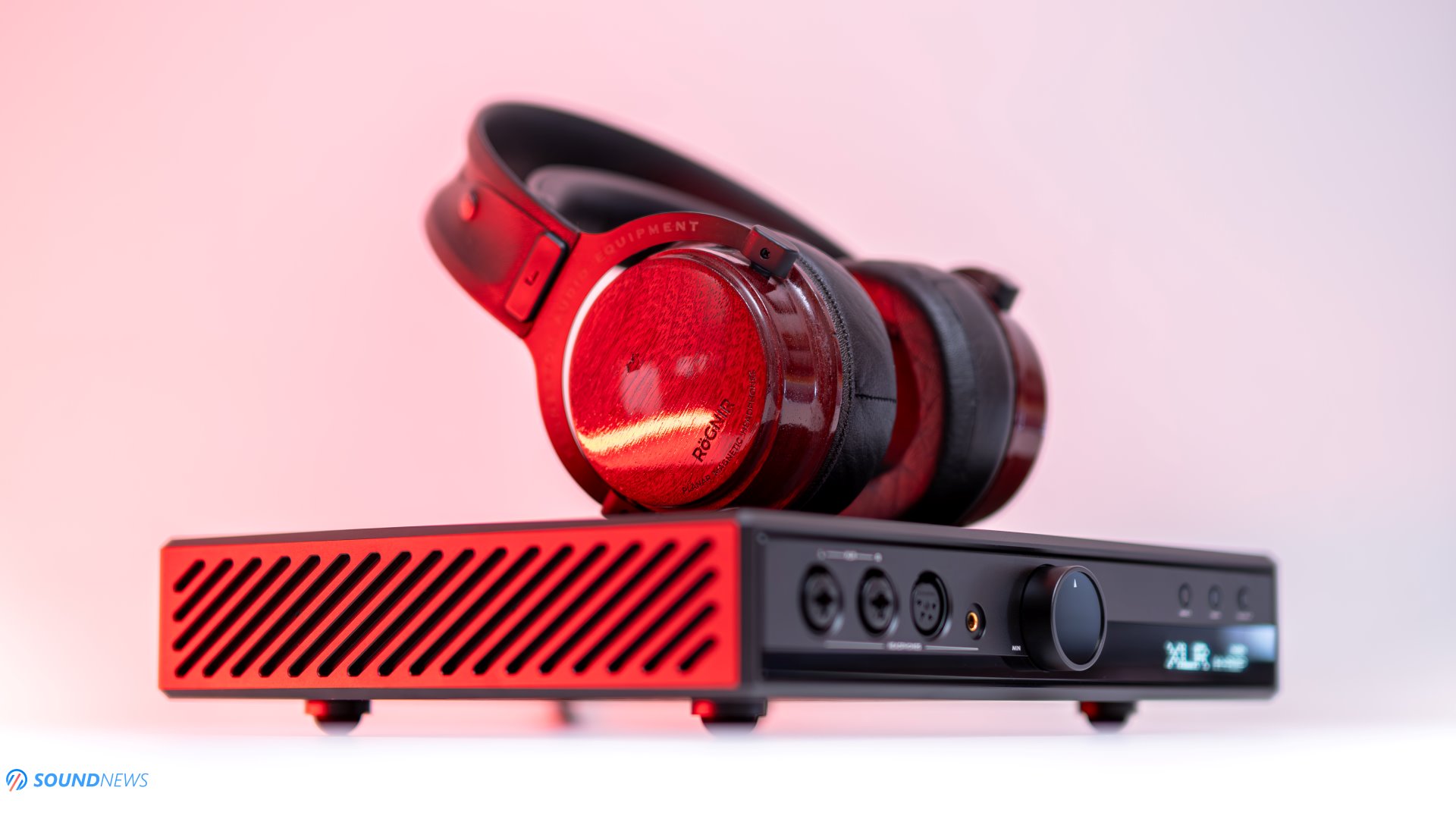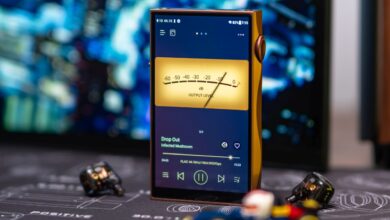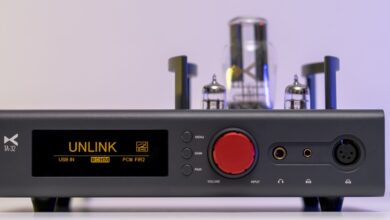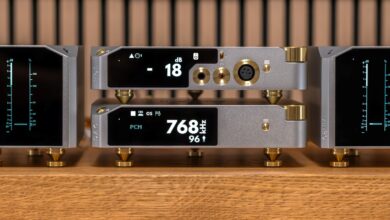HiFiMan PRELUDE Review & Comparison – Amplifying Excellence?
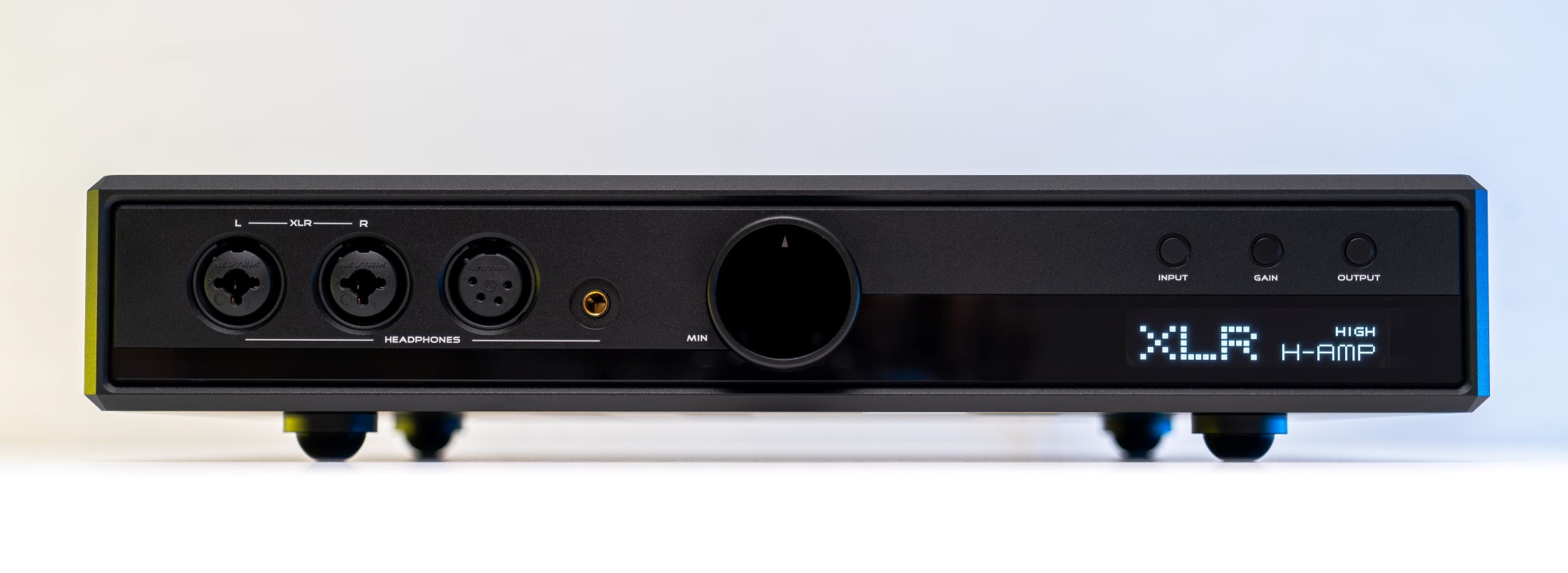
When you look at major HiFi companies, you’ll notice a fascinating trend: at some point, they all begin to create an ecosystem, brick by brick. And honestly, it makes perfect sense! The term “system matching” can send chills down the spine of even the most seasoned audiophiles like me. Spending months, sometimes years, fiddling with gear to find that perfect component isn’t for the faint-hearted; it can be downright exhausting. In the world of head-fi gear, we still face the critical task of selecting the right components and headphones. But when everything finally clicks into place, it’s pure magic. You’ll feel the goosebumps wash over you, and a wild smile will spread across your face.
Over the years, I’ve come to realize that the thrill of reaching the final destination isn’t as rosy as I once imagined. I thrive on experimentation and the quest for improvement! It’s in our nature as humans to continually learn and explore the world around us. While I can’t speak for everyone, I know I’m eternally curious and ravenous for knowledge, and I’ll probably never retire because I need to satisfy my curiosities every single day of the week!
As HiFi companies craft their ecosystems, two big advantages emerge. First, you can experience everything you need from a single brand, which makes it easier to understand their signature sound. Second, you can finally put your worries about system matching to rest, knowing that most of these electronics will meld together seamlessly with their music-making machines, be it headphones or speakers.
It’s no surprise that the Sennheiser HD800/S/820 pairs beautifully with their HDV820 DAC/Amp combo, or that the Erzetich Charybdis sounds nothing short of phenomenal with their Deimos and Scylla amplifiers. And this list of wonderful pairings continues to grow every month!
I vividly recall the day I first unboxed the HiFiMan Susvara – the awe I felt was quickly followed by shock and dread. These headphones sounded astonishingly clear compared to anything else I had on hand! Then came the realization: none of the headphone amplifiers in sight were capable of fully driving the Susvara to its full potential. In the years that followed, let’s just say I acquired more headphone amplifiers than a sane person would ever need. I even swapped out several power amplifiers, driven by one burning question: could I unleash the Susvara’s full power performance-wise?
The Susvara inflicted more damage on my wallet than any other headphone or speaker I’ve ever encountered, and you know what? I absolutely loved it! Finding the perfect amplifier for the Susvara is no longer a question I ponder. If you’re an avid reader of ours, you’re already well aware of why!
It was only a matter of time before HiFiMan started developing their own DACs, all-in-one devices, or, for those with deeper pockets and more stubborn preferences – dedicated headphone amplifiers biased into Class-A operation. I genuinely enjoy all-in-one devices with a long list of features, but I must confess that I lean toward standalone devices. I appreciate the dedication to achieving the best sound quality that often accompanies these designs.
As luck would have it, I’ve had the opportunity to try most, if not all, of HiFiMan’s creations, and the latest, the Goldenwave SERENADE, left an indelible mark on me. Not only was it more than capable of keeping pace with dedicated streaming DACs, but its headphone amplifier section could hold its own against mid-level fully discrete amplifiers, effortlessly driving almost anything, including the legendary Susvara. So, when I found out that the PRELUDE was on its way for a review, I was excited! I knew things were about to get more interesting, as I would be employing my streaming equipment, D/A converters, and more – leaving the heavy lifting to the PRELUDE.
This beauty isn’t just any headphone amplifier; it represents the pinnacle of HiFiMan’s creations to date, offering more power, a heftier build, and a strikingly bold design. It’ll set you back a pretty penny – €2699 locally or $2499 across the pond.
As we dive deeper into this review, prepare for more than just a breakdown of performance metrics. I’ll take you on a narrative journey – a personal exploration of how the PRELUDE can transform your auditory experience not just as a headphone amplifier but as a preamplifier in a thoughtfully crafted stereo rig. I’ll dive into its design, audio performance, and value proposition, and I’ll put it up against competitors in the same segment, evaluating factors like soundstage, detail retrieval, and tonal balance. So, grab a drink, get comfy, and brace yourself, this is going to be an exciting ride!
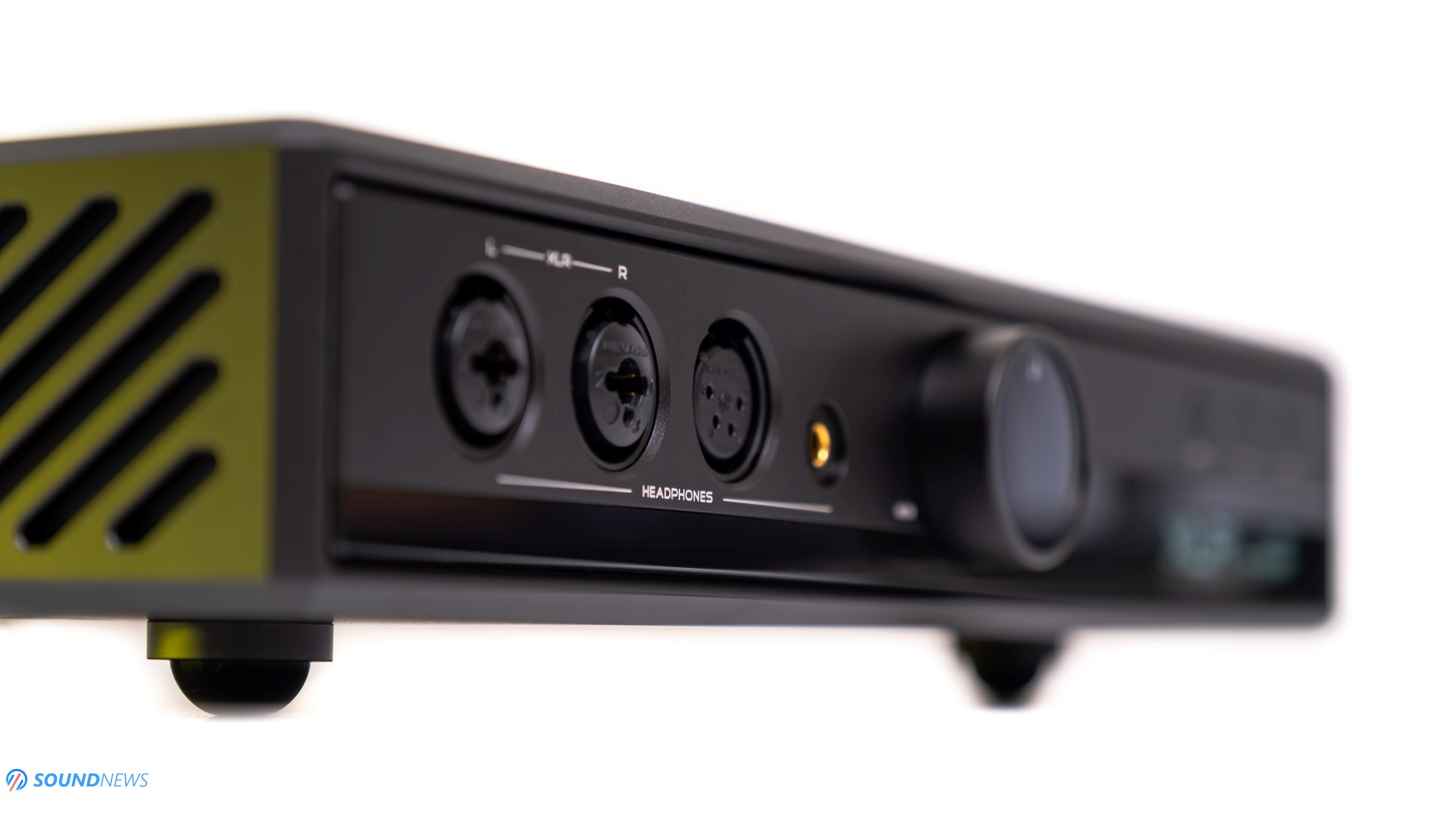
Design & Build Quality
If you take a look at HiFi gear that HiFiMan has crafted before, such as the well-known EF series, you’ll observe a similar pattern. Usually, these devices share a similar thickness (the EF1000 being an exception), material choices, and design. There’s nothing inherently wrong with that approach, but their enclosures weren’t especially thick, and on some models, you could spot a fair amount of plastic and resin, used strategically to keep production costs low.
The PRELUDE, however, stands out distinctly from anything emerging from the EF lineup. Its metalwork is noticeably thicker. In all honesty, I don’t believe I’ve ever come across a solid-state headphone amplifier sporting this kind of thickness. Such attributes are significant to me because, once you’re past a certain price threshold, you expect more than just excellent sonics; you yearn for impressive aesthetics and durable materials that can withstand a few hard knocks. The PRELUDE is undoubtedly built to a much higher standard than any of their earlier iterations. The SERENADE remains a captivating unit, featuring a CNC-machined case, thick plates, and rounded corners among other desirable traits, but the PRELUDE feels like a big step up in terms of build quality.
Truly, the only solid-state amplifier I can think of that rivals the PRELUDE in build quality is the Enleum AMP-23R, which also felt akin to a petite Challenger 3 main battle tank. Given that the PRELUDE is biased into a more profound Class-A operation compared to the rest of their lineup and incorporates larger transistors with higher power output, its tank-proof case doesn’t just look formidable; it also serves effectively as a massive heat sink, efficiently distributing heat across the unit’s surface for a lengthened lifespan.
However, the PRELUDE isn’t without its thorns. One aspect I don’t particularly favor is the substantial amount of heat the unit generates, resulting in numerous openings fashioned underneath it. The sides of the unit are also CNC machined to expand the dissipation area, which are clever adaptations to manage heat generation, but the short rubber feet don’t assist much. With forthcoming models, I’d like to see a greater elevation from the ground, featuring enhanced metallic feet. For improved elevation and thus cooler operation, I’ve installed four ISO-Pucks Mini from ISO Acoustics, which have reduced the unit’s temperature by an average of 2 degrees Celsius. For this reason alone, I would recommend against placing your DAC or streamer on top of the PRELUDE – better yet, nothing should rest on top of the unit while it’s channeling power to your headphones.
The second area where the PRELUDE doesn’t quite hit the mark is in the quality of the volume knob and the minimal resistance it offers when you adjust the volume. Notably made out of plastic, it’s the only plastic component you’ll find on the unit. When handling sensitive headphones or IEMs, exercise caution when adjusting the volume, as there’s little to no physical resistance, which could inadvertently overdrive your precious IEMs. Gentle adjustments will help safeguard both your equipment and your hearing.
Putting these issues aside, there isn’t much else to complain about. The PRELUDE is built to withstand the rigors of time, solid as a rock, donning a bold black finish, and highly resistant to scratches thanks to its sandblasted surface. This is what a proper headphone amplifier should look like, and as an added benefit, it occupies minimal desktop space.
The SERENADE was already a robust unit with its 3.9-kilo body weight; however, the PRELUDE competes in the heavyweight category with its 6.5-kilo enclosure, a testament to the significant changes made both inside and out.
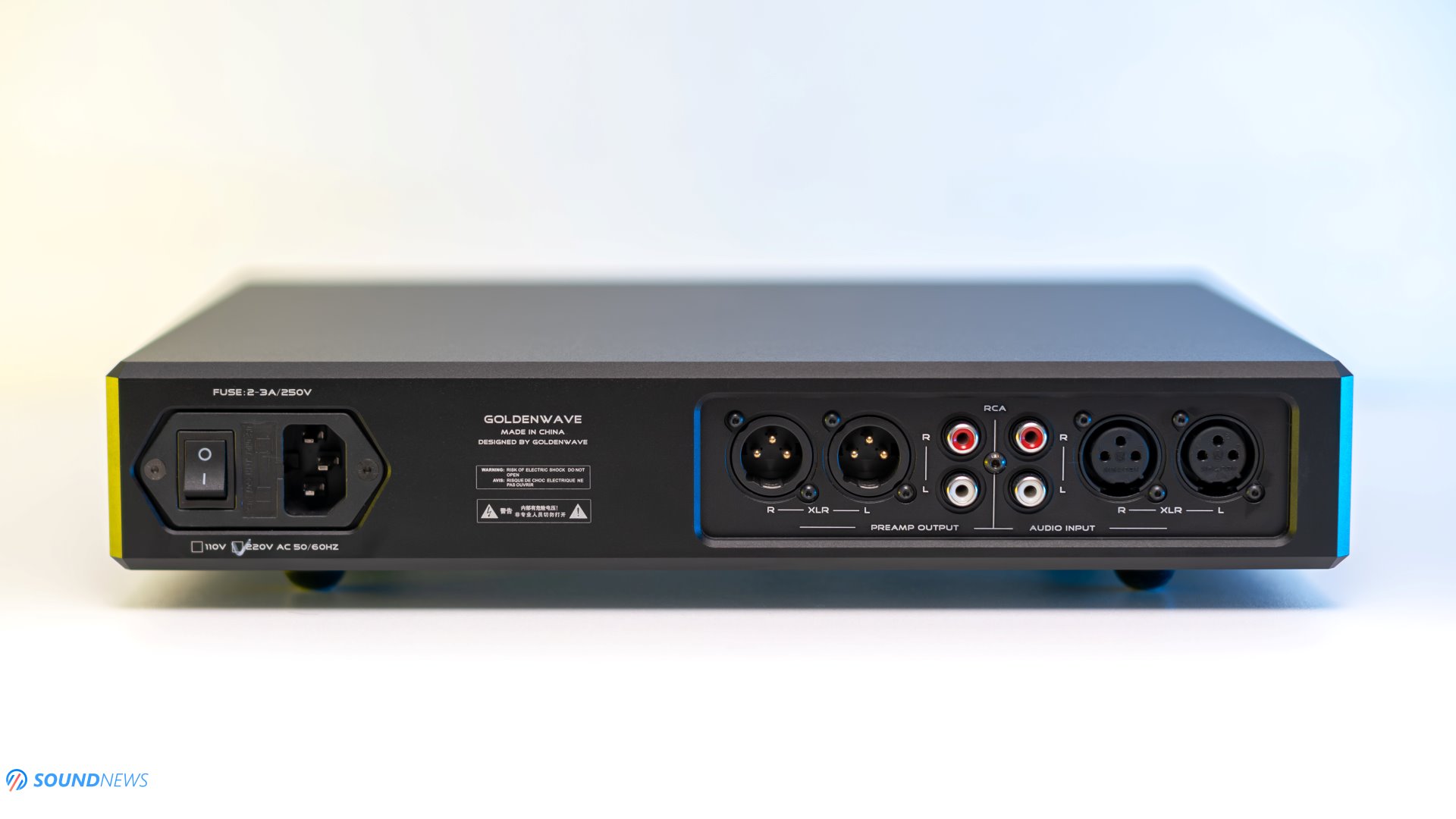
Controls & Connectivity
The front panel of the PRELUDE is a classy blend of functionality and sleek design, featuring CNC-milled craftsmanship with a hidden monochrome screen that lights up when you power on the unit. Thankfully, it won’t blind you during those midnight jam sessions, allowing you to enjoy the subtle reassurance that your gear is humming along perfectly.
On the front panel, you’ll find four headphone outputs. The first two are combo jacks that can be used as 6.35mm single-ended outputs, or you can pair them for a dual 3-pin balanced output. Fortunately, the era of dual 3-pin connectors is fading, given their higher cost and no real advantage over the more standard 4-pin XLR jack that you can see nearby. The final output is a 4.4mm Pentaconn jack, perfect for driving portable headphones and IEMs. Positioned neatly in the center is a volume knob that doesn’t trigger any OCD tendencies, and aligned to the far right are three buttons that allow you to select your desired input (RCA or XLR), output (PRE or HP Amp), and gain setting (Low or High).
Turning to the back panel, you’ll notice pairs of XLR and RCA inputs complemented by mirrored analog outputs, emphasizing the PRELUDE’s capability to function as a full-fledged active preamplifier. It’s important to highlight that this isn’t merely a passive preamplifier tasked only with managing the volume of the subsequent power amplifier. Instead, it boasts an active configuration, employing an independent Class-A output stage that ensures natural timbre and exceptional control over the speakers, but more on that shortly.
And here’s a travel tip: the PRELUDE isn’t a fan of universal power tours. It commits to either a 110V or 220V power supply. So, be sure to pick the right model for your local voltage, because a perfectly tuned audio experience is worth the forethought!
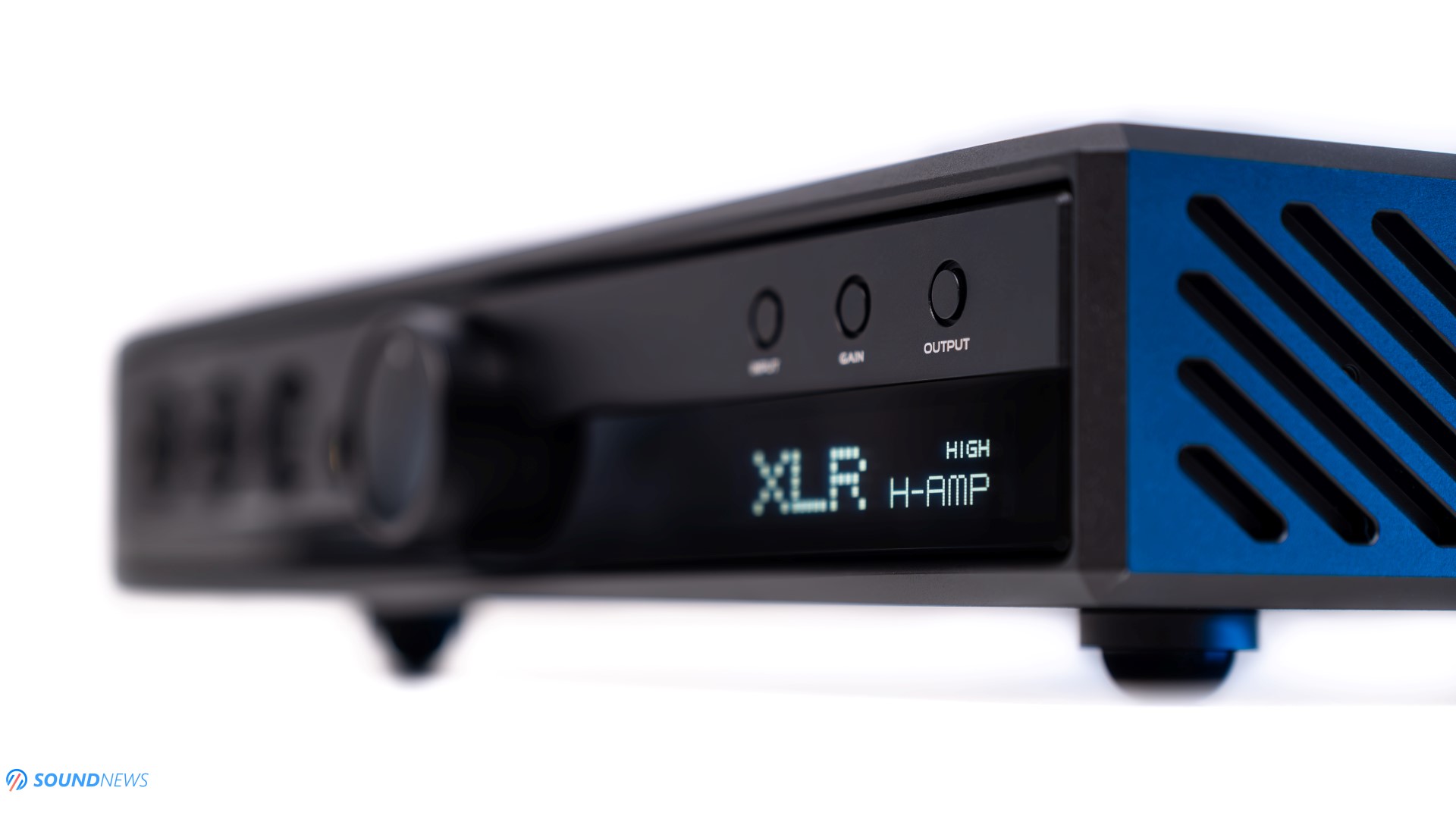
Under its Hood
HiFiMan proudly boasts the PRELUDE as a fully balanced Class-A MOSFET-based high-current headphone amplifier and preamplifier. With its imposing size and weight, it’s currently the biggest, meanest, and hottest beast that HiFiMan has unleashed in the headamp and preamp arena.
Those who know me, recall my irresistible curiosity to explore the innards of gear, inspecting PCB layouts and components with meticulous attention. Sadly, the thread-locked T8 screws on the PRELUDE kept its secrets closely guarded, leaving me to rely on images from HiFiMan’s website for the inside scoop.
Here’s what we know: op-amps have been dismissed in favor of fully discrete components on the PCB. Even if you’re feeding it single-ended sources, the PRELUDE works its magic by converting the SE signal into a balanced one to fully exploit its balanced topology. It offers two gain levels, Low and High, though the exact gain in decibels remains a mystery.
With the ability to deliver a whopping 10 watts per channel into 32 Ohms through the balanced outputs and 1 watt per channel into 300 Ohms, the PRELUDE stands tall among the most powerful solid-state headphone amplifiers ever crafted.
One feature might not set hardcore head-fi enthusiasts ablaze with excitement but could indeed light a fire under stereo heads: an active preamplifier circuit. This circuit operates independently, embracing the same Class-A output architecture and utilizing a range of analog relays to ensure precise volume control at any gain setting or volume position.
The heart of its power supply comes from a customized low-noise linear transformer, likely around 80 to 120 Watts, which then gets regulated and filtered to deliver pristine power to everything under its hood.
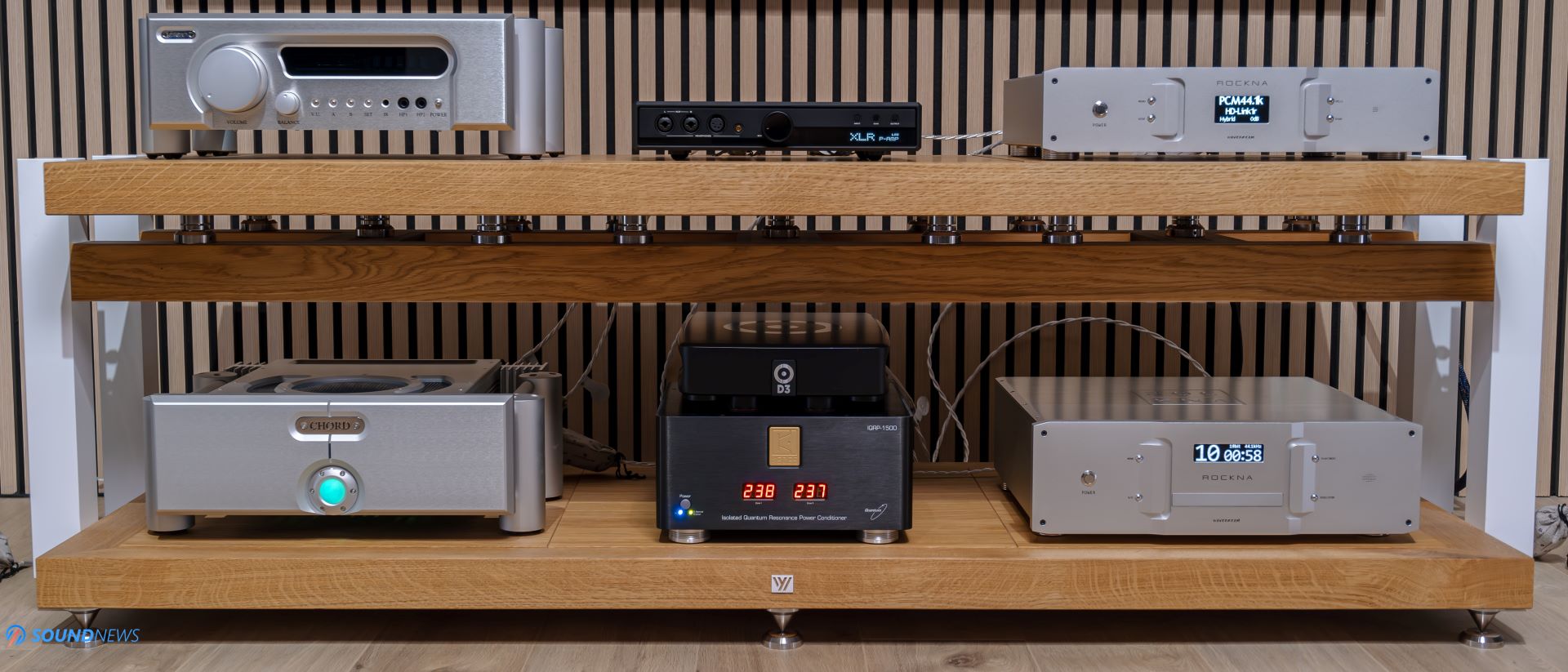
Test Equipment
The PRELUDE, with its remarkable versatility, became a central figure in both stereo and head-fi setups, leading it to be part of two distinct configurations:
- Office Setup: Here, it pulled duty as a dedicated headphone amplifier, paired with a Rockna Wavedream Signature DAC and a Rockna Wavedream NET 4TB Roon Server/Music Server/Wired Streamer/CD Player. I ensured peak performance by isolating the Ethernet connection with two media converters (Ethernet > Optical > Ethernet) and powering them, along with the wireless router, using a KECES P14 linear DC power supply. Every component was powered through a Plixir Elite BAC1500 balanced and isolated power conditioner.
- Living Room Setup: Later, I transitioned it to the living room to act as a preamplifier managing a Chord Electronics Ultima 5 power amplifier. The Wavedream NET 4TB continued to serve as the Roon core, fed by the Ansuz Power Switch D3, and followed by the Wavedream Signature DAC. All five units were powered by a KECES IQRP-1500 balanced passive power conditioner.
With all systems prepared and finely tuned, I’m ready to dive into the world of music. Let’s give those eardrums a well-deserved treat!
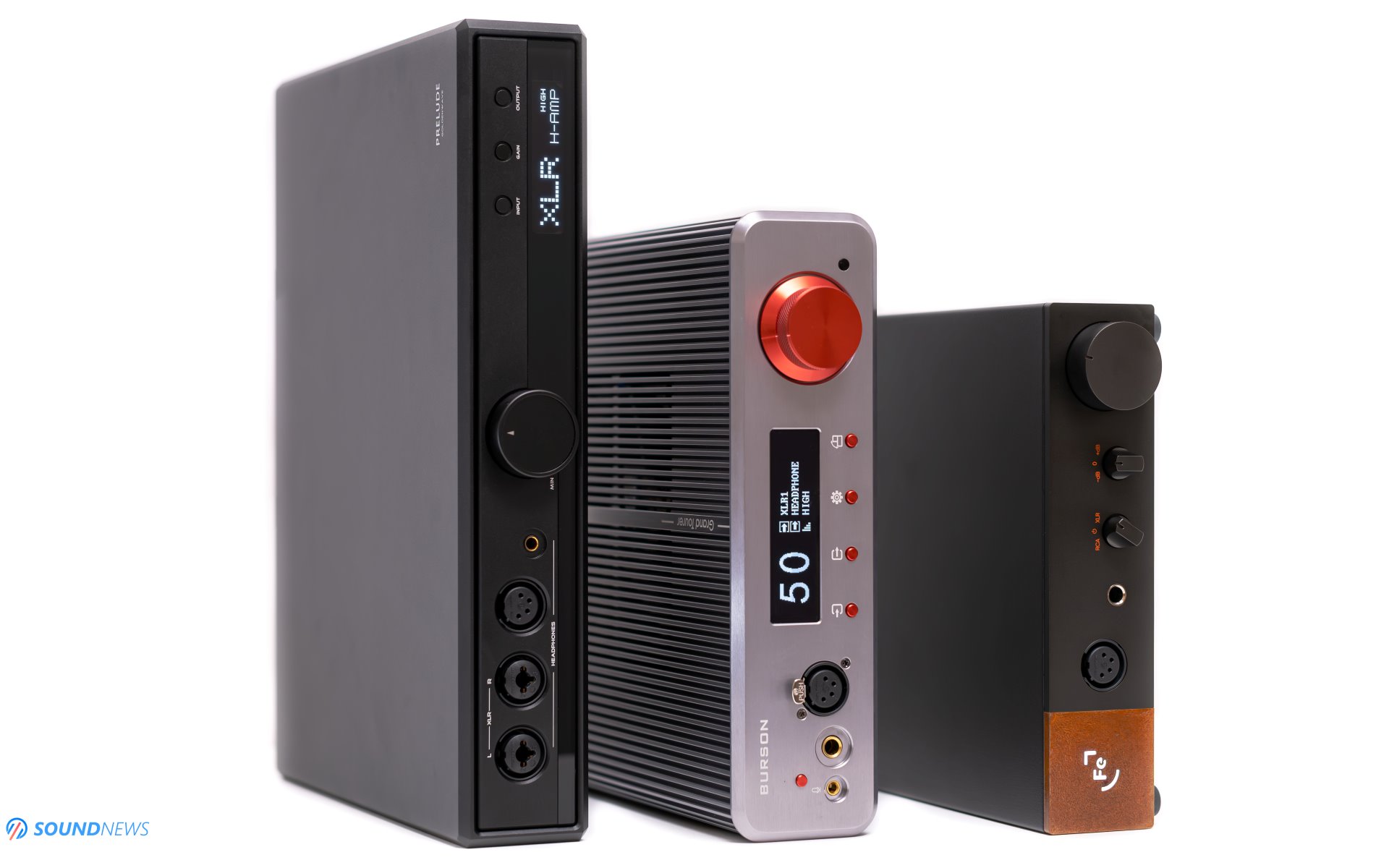
Sound Performance
I. Preliminary Sound Impressions
Right from the get-go, even without any burn-in, the HiFiMan Goldenwave PRELUDE started showing off its distinct character and laid-back attitude, but let’s pause that for a moment and remember what others are doing. After testing tens of headphone amplifiers around here, I realized that most are telling the same story all over again with minor adjustments to their output power, casework, and price. Most of them are trying to be ultra-linear and honest-sounding, without touching the frequency response or altering the tonality of the source material. However, in reality, the picture I’m getting is very different. The smallest units that usually carry an affordable price point are draining the life from music. There was a particular headphone amplifier from SMSL that I needed to review but ultimately refused, as it simply removed way too much midrange presence and bass oomph, completely draining the life out of instrumental music while removing the engagement factor from modern tunes. I’m sorry, but this is no longer ultra-linear or honest-sounding; it’s plain wrong, something that I won’t recommend around here.
At the end of the day, an amplifier of any kind shouldn’t interfere with the original signal; it should stay out of the way and let the music flow as the artists intended. It’s easier said than done, because usually, such amplifiers would need to have an overkill power supply section, a fully discrete and Class-A amp stage, and massive headroom should always remain on tap, even with low-sensitivity headphones. That’s precisely how from $500 headphone amplifiers, we arrived at $2,500 or even $15,000 headphone amplifiers. Such units won’t interfere with the tonal balance and let the music flow as it should.
I’m happy to report that the PRELUDE is without a doubt one of the few amplifiers that puts a much higher accent on a life-like tonality and amazing tonal balance that does justice to all musical genres while driving a wall of headphones. From the solid-state flock, I can name maybe 4 or 5 amplifiers that were blessed with the right tonality, without limiting the power output, dynamics, or headroom.
After a couple of minutes, the amplifier stabilizes its temperature, and the sounds become what I would describe as liquid and soothing, bumping the midrange purity to a level that only tube amplifiers have mastered so far. Some might call it sweet or warm-sounding since the bass and midrange are infused with lots of energy, while tightly controlling the treble output and removing the glare and listening fatigue. Considering that most high-end headphones are going for a dead neutral presentation, be they from HiFiMan, T+A, Abyss, Audeze, or Dan Clark Audio, aiming to provide as much information to the listener and unearth obscure levels of detail, a life-like presentation coming from the amplifier makes a lot of sense and it’s exactly what I’m getting from the PRELUDE.

II. Noise Floor & IEM Compatibility
Considering that the PRELUDE was designed as the ultimate solution for taming inefficient headphones, whether they be low-sensitivity planar or high-impedance dynamic models, it might seem like IEMs would be out of the equation, and to an extent, you’d be right. A whopping 10 Watts per channel is capable of driving most IEMs to eardrum-piercing sound pressure levels, with only one milliwatt needed to achieve this. This makes it a potential eardrum rattler if you’re not careful with the volume control.
This chapter, unfortunately, isn’t all sunshine and rainbows, as I encountered three issues when using ultra-sensitive IEMs. Firstly, and possibly most irritating, is that even at the lowest volume setting, music still plays through IEMs. Secondly, regardless of the gain setting, a low-intensity hum is audible to the untrained ear. This hum becomes more pronounced if you pause your music, and as the volume increases, so does the noise floor of the amplifier.
I tested three pairs of ultra-sensitive IEMs, and with each, the amplifier’s noise floor was readily apparent, with music always faintly present in the background at the lowest volume setting. An adjustment from High to Low gain seemed nearly negligible; although I didn’t measure the output, it felt like merely a ~2 to 3 dB decrease at best, hardly noticeable. And lastly, there is very little play on the volume knob until the IEMs are becoming too loud, even on the low gain. You start slowly turning up the volume and it becomes too loud a second later. The highest volume I could reach with these IEMs was the 9 O’clock position, meaning you might find yourself continuously tweaking it to settle on the right level.
Thankfully, I didn’t detect any noise or hum with the most sensitive desktop headphones I have, such as the Apos Caspian, which sounded great on low gain. I presume that Focal and Grado headphones would perform similarly, without exhibiting the noise floor issues.
Ultimately, I wouldn’t recommend using ultra-sensitive IEMs with the PRELUDE due to these concerns. However, it will work well with sensitive desktop headphones, regardless of their impedance or sensitivity.
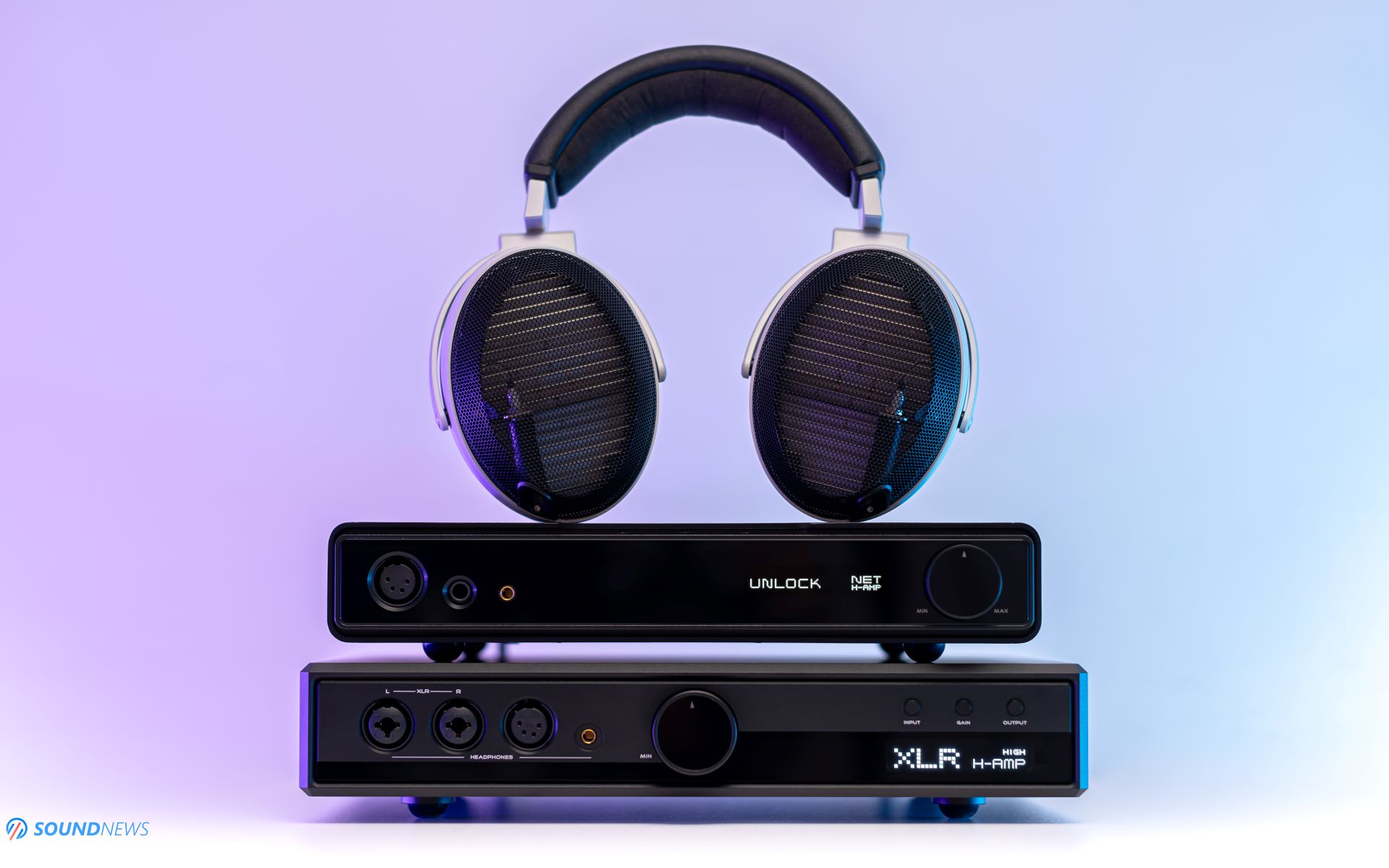
III. Power Output
Not too long ago, I had the chance to test HiFiMan’s SERENADE and was impressed by its driving prowess. While it delivered 4 Watts per channel into 32 Ohms, hardly what you’d expect for Susvara-pounding performance in everyday scenarios, the SERENADE managed to drive the Susvara at 95dB, with headroom left for potential dynamic swings. Unlike op-amp-based amplifiers, which typically struggle to leverage the same power output with the Susvara, not all Watts are created equal. Now, comparing the PRELUDE, a dedicated headphone amplifier versus the All-In-One SERENADE, it commands a doubled price tag. It’s no longer in the affordable category, but if only the best will do, the PRELUDE with its robust 10-watt per channel output feels as if it’s toying with headphones, even on the low gain setting.
Currently, my go-to headphones are the HiFiMan Susvara and T+A Solitaire P, as these are among the few capable of doing justice to a wide array of music genres while resolving extraordinary levels of detail. Switching back to the rest of my collection feels like opting for 1080P video over 4K HDR. Ever since acquiring the Raidho TD 2.2 speakers, enjoying entry to mid-level headphones has felt increasingly difficult.
The PRELUDE represents a significant leap over any previous HiFiMan models, not only because it can easily drive even the heaviest loads but also due to its exceptional tone and timbre, consistently bringing more life into your music. On high gain, the greatest volume I could ever reach with the Susvara on tracks with high dynamic range was at the 1 O’clock position, leaving about 40% headroom for wild dynamic swings. The electronic music was unfazed; bass performance remained powerful, with energy intact and long decay sustained. When returning to complex music renditions, such as orchestral or classical masterpieces, the power reserve left a positive impact as notes maintained clarity and separation, without bumping into each other.
The second hardest-to-drive headphone in my stable is the T+A Solitaire P, and unsurprisingly, the highest volume I could reach was the 11 O’Clock position on its knob, leaving an almost infinite headroom on tap. The Solitaire P sounded exactly as I know them to be on world-class amplifiers, highlighting an even stronger dose of resolution, maintaining a faster pace, rhythm, and timing, albeit with a slight compromise in midrange delivery. They sounded a tad less involving and natural compared to the Susvara, which has a unique way of presenting music with deep emotional engagement.
As you can imagine, anything else from my headphone wall was driven with aplomb. Regardless of the headphones and technology used, the PRELUDE was remarkably adept at controlling their drivers, showcasing the beautiful side of music listening. It provided a consistent performance, ensuring that each headphone revealed its best character and dynamics. The PRELUDE effortlessly brought out the nuances and detailed textures of every track, making each listening session a captivating experience.
The balance of tone, power, and precision ensured that the PRELUDE not only pushed headphones to their optimal performance levels but did so with a flair that kept the audio engaging and immersive. Its ability to preserve the integrity of the musical presentation, from deep bass notes to shimmering highs, while maintaining a grounded and lush midrange, made it a standout performer in my head-fi battle station.
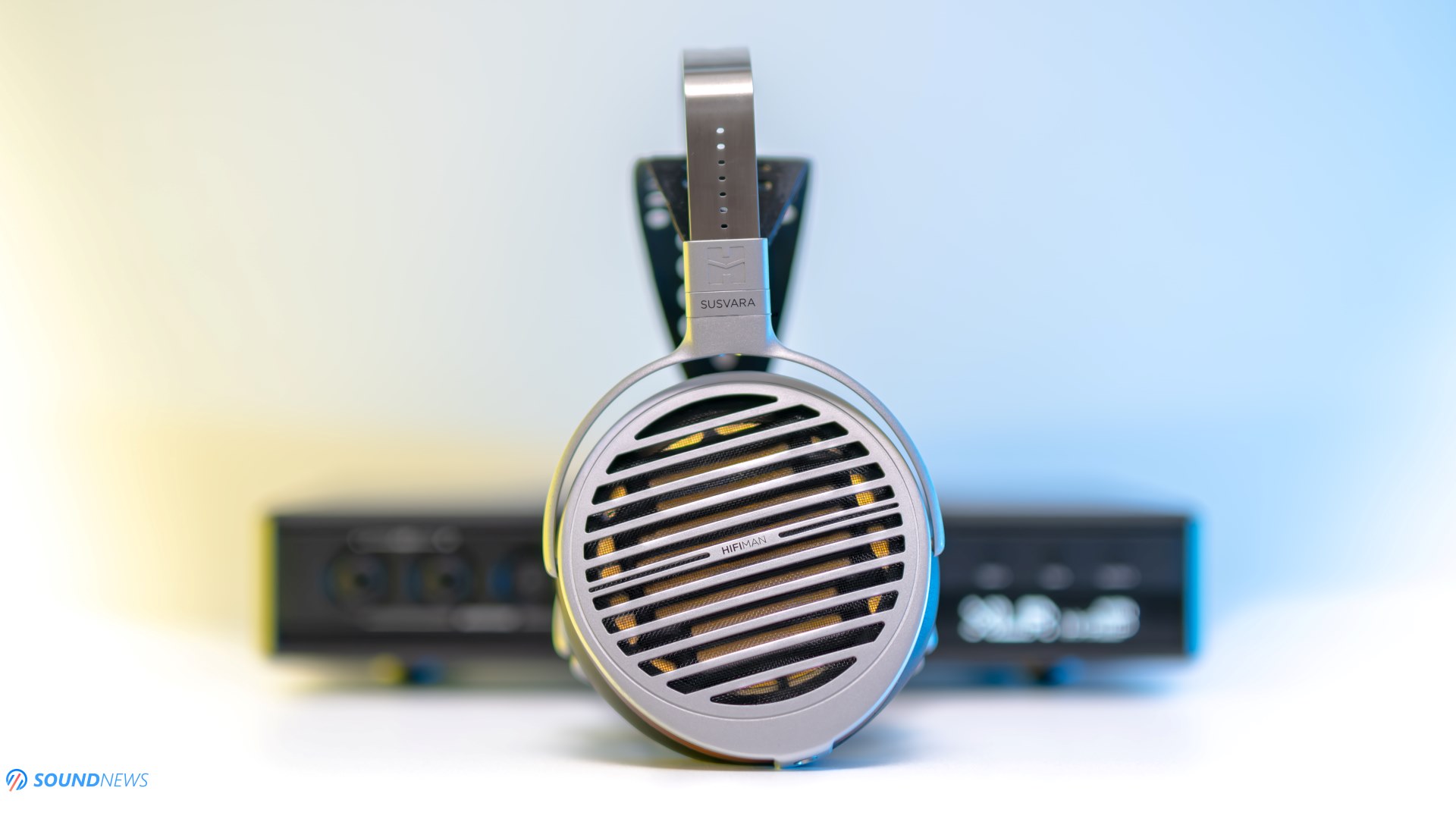
IV. Dynamics & Transients
While the dynamics and transient response are directly influenced by the amplifier that drives your headphones and speakers, the downstream equipment plays a similar role, albeit to a lesser degree. Over the years, I have invested in world-class digital to analog converters, digital transports, and wired streamers because they are crucial when properly assessing amplifiers, headphones, and loudspeakers. For me, the source is more important than the amplifier that follows due to the GIGO effect (Garbage In -> Garbage Out). Over the years, I’ve observed that D/A converters have their own voicing; they contribute significantly to the dynamics and transients of a system. As of today, I’ve settled on the fastest, punchiest, and most revealing converters available, ensuring that I’m feeding the cleanest possible signal to the PRELUDE.
Right from the start, I noticed a slightly slower pace with the PRELUDE compared to the Ferrum OOR and Burson Soloist 3X GT, both fully discrete headphone amplifiers that I greatly enjoy. The Soloist boasts a more linear approach while keeping up with lightning-fast tunes, whereas the PRELUDE and OOR have a thicker tone and timbre, emphasizing bass and midrange notes while rolling off some upper treble information. The Soloist 3X GT impresses with a strong punch in the lowest octaves, though it doesn’t sustain that punch for extended periods. The OOR follows with its magical midrange, allowing the bass to linger a millisecond longer. In my opinion, the PRELUDE offers the longest decay and sustain in the bass, mimicking the sound of well-designed tube amplifiers. The transients aren’t lightning fast on the PRELUDE, but the unit still responds swiftly to the signal from the D/A converter. Notes transition more smoothly, giving you more time to appreciate the beautiful overtones, especially with acoustic music. It maintains a slightly colored approach to frequency response, injecting more life into the midrange and bass while gently rolling off the upper treble. More importantly, it provides impressive control over headphone drivers, ensuring nothing feels out of place or blurry, even when notes start to overlap in complex pieces.
After several back-and-forth comparisons with close competitors, I was genuinely surprised to hear the smoother note transitioning on the PRELUDE while maintaining a strong kick in the lowest octaves. The PRELUDE can slam and pound when the music demands it and sounds snappy when modern tunes are on your playlist.
From the units I have tried before, the Flux Lab Acoustics Volot is even smoother sounding, not focusing on rapid dynamic shifts, whereas the PRELUDE sits somewhere between the Volot and Ferrum OOR. It excels with blues, jazz, classical, and acoustic music but also performs admirably with rock, metal, and electronica, offering a more universal sound.
In the world of analog designs, MOSFET transistors are typically regarded as thicker, weightier, and fuller sounding compared to ultra-linear bipolar transistors, while JFETs usually sit somewhere in between. As a fully discrete MOSFET amplifier, the PRELUDE definitely exhibits added oomph in the lower frequencies, with the guttural energy of male vocals and longer decay of string-based instruments. It’s akin to listening to a well-crafted tube amplifier, without the hassle and low lifespan of vacuum tubes.
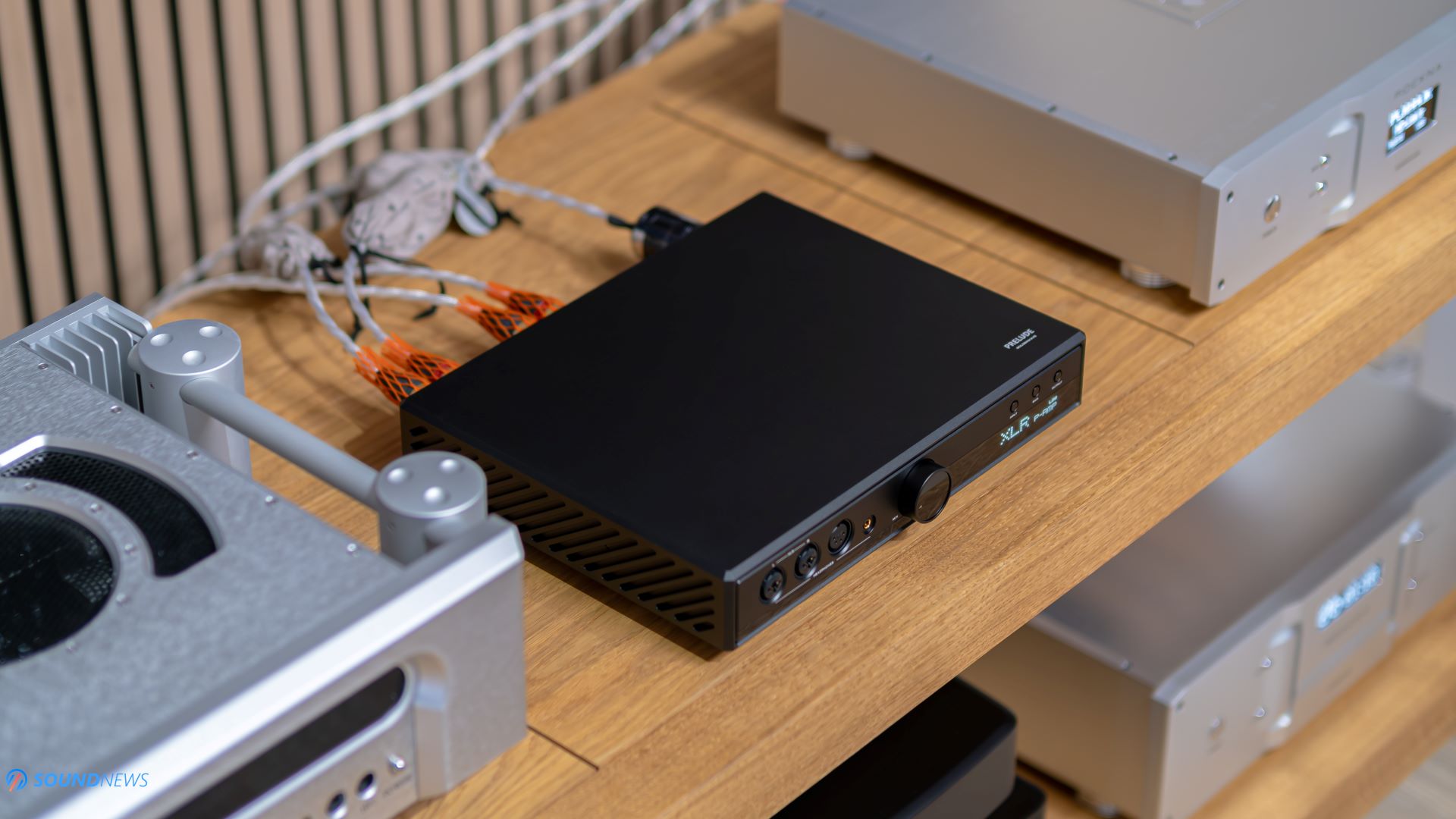
V. Soundstage & Imaging
Alright lads, the power output is impressive, the transient response not so much, the tone and timbre are as good as it gets, and the noise floor wasn’t the bee’s knees with IEMs, but how about the soundstage, depth, and imaging?
Is it airy, spacious, or deep-sounding enough to hear the backing vocals without closing my eyes? How about all of the above? The Ferrum OOR and the Burson Soloist 3X GT might win a round or two in a few key areas, but those aren’t as spacious nor as deep-sounding as the PRELUDE is. I’m not sure if that is another trick of MOSFET transistors, or maybe the linear transformer is freeing the sound and letting it fly in all directions, but clearly, the PRELUDE knows how to deal with live recordings and acoustic stuff.
Firing up the latest Luck and Strange by David Gilmour (Qobuz / Tidal) proved to be a revelatory experience in the true meaning of the word. The album itself is a masterpiece; I get killer vibes while listening to it, and it’s much more enjoyable compared to The Dark Side of the Moon Redux by Roger Waters. I like both of these legendary artists and human beings, but David Gilmour is so much closer to my personality. I was mesmerized by the flow and easy-going nature of this album, aligning perfectly with the PRELUDE, somehow hiding the dark side of the Susvara and Solitaire P, while boosting all of their virtues.
Let’s be honest, while the Susvara was dead gorgeous in terms of tonality and resolution, it couldn’t outperform a substantial number of headphones when it came to soundstage. They have outstanding separation and transparency, locking on the tiniest details always felt like child’s play, but the sounds weren’t particularly hovering at an arm’s reach, how their HE1000SE were doing so easily.
On the PRELUDE, the Susvara isn’t riding on Pegasus wings like they do on the Trafomatic Primavera, sounding bigger than life and completely unshackled and free. BUT there is some of that magic with the PRELUDE. The sounds don’t intertwine and don’t crash on top of each other. There is still a very palpable sense of air that pushes the notes from each other. Driven by the PRELUDE, the Susvara is no longer congested and upfront-sounding, and that’s the beauty of it.
What’s interesting is that a much pricier Enleum AMP-23R ($6250) that I still use as my daily driver amplifier, sounds exactly as spacious and deep. Is it a coincidence or not, but AMP-23R is also a MOSFET-based fully discrete amplifier that offers a very similar tone & timbre to the PRELUDE. This similarity might suggest that there’s something special about how MOSFET-based designs handle soundstage and imaging, offering a depth and expansiveness that makes listening a truly immersive experience.
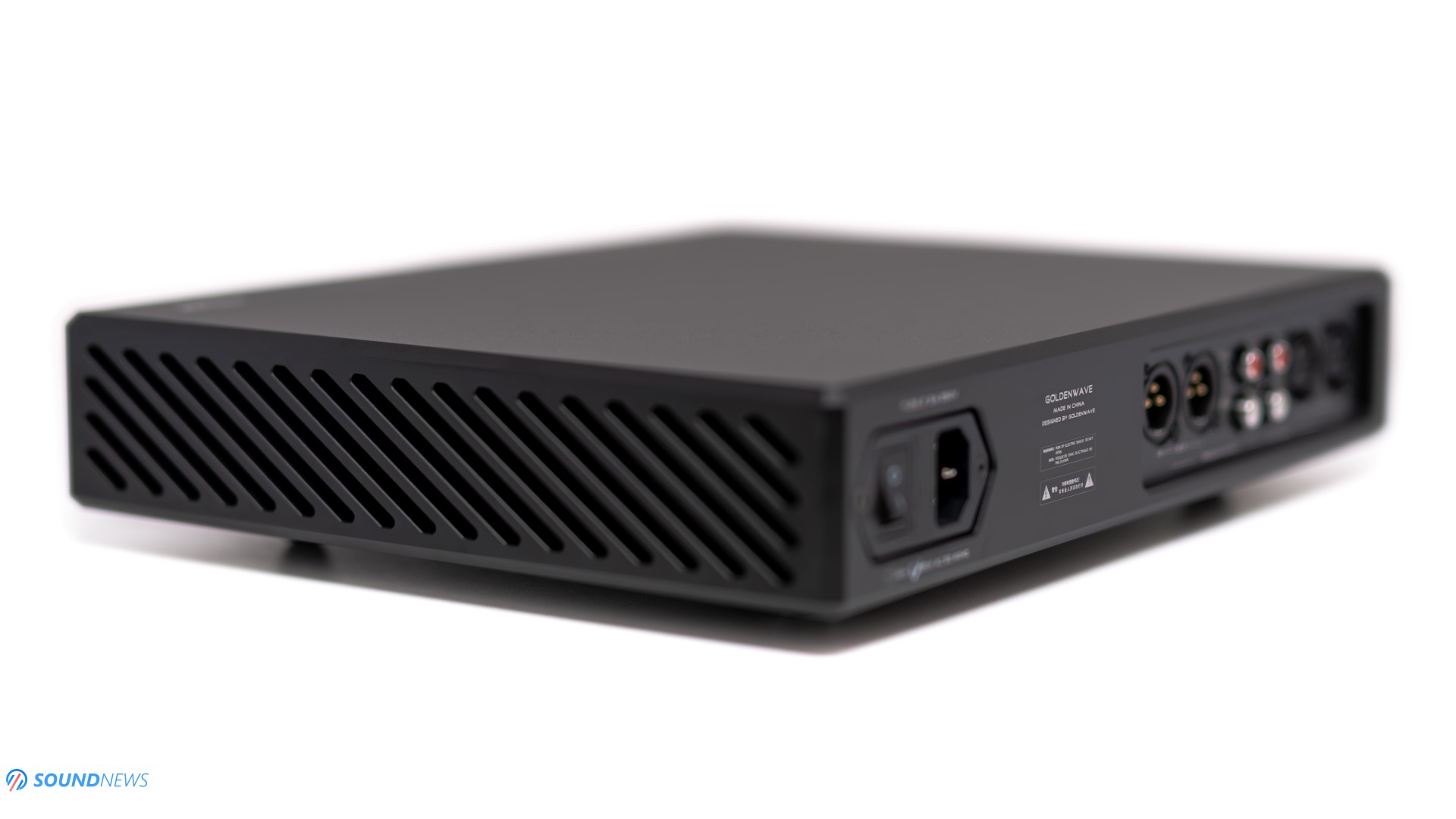
VI. Resolution / Detail Retrieval
The PRELUDE is not shooting hundreds of needles into my ears, nor does it over-sharpen the overall picture when music does its thing. On the contrary, it calms the upper region, taking away some of the sharpness and leading edge. Less experienced headphiles might think this stunt negatively affects resolution on the microscale, but I’m here to tell you that resolution has nothing to do with sharpness or leading edge. Resolution is one thing, and treble sharpness is something else completely.
The EF500, EF600, and SERENADE were already quite impressive in this department, but since I’m describing an amplifier-only unit, the resolution can go (much) higher with the right source and D/A converter. I don’t like to brag about my accomplishments, but I think I have arrived at the end of the road when it comes to D/A converters. With the Rockna Wavedream Signature in place, getting the signal from an equally impressive Roon Server (Wavedream NET), it wasn’t a challenge trying to hear the smallest nuances and all the small things that I wasn’t supposed to hear.
The PRELUDE does it nonchalantly; it’s not grabbing your attention with its detail retrieval skills. It does it by default, but without shouting its lungs out. The finer details are all there, but they aren’t delivered in an overly sharp and overly defined way, more like hearing a live performance rather than a recording…if that makes any sense. However, the pixel-peeping crowd might look somewhere else; THX-AAA and NFCA amplifiers are still providing an extra dose of sharpness and outline at the cost of being less natural.
As for me? I chose life-like textures and a relaxed presentation over the last drop of information, and it seems that the PRELUDE was designed with the same principles.
Requiem: Pie Jesu by Turtle Creek Chorale (Qobuz / Tidal) is a track I usually listen to after a hard day’s work. Writing, shooting, filming, editing, and tidying up everything takes me more than 10 hours a day, after which I need to recharge my dopamine-powered cells and prepare for the next day. I listen to this track for many reasons: it calms my spirit, it charges my internal batteries, and the soprano voices always send shivers through my spine. It’s a short but incredibly complex track, with tens of instruments and backing vocals, all of which create small movements in the room that you can hear if you put your hearing abilities to good use.
The PRELUDE not only was able to pinpoint every note in the auditorium but also boosted the warmth and the beautiful overtones, adding more life and midrange purity into something that truly needs such things, like the T+A Solitaire P. The additional warmth contributes to the sonic beauty and emotional engagement, transforming the music into a soothing experience after a demanding day.
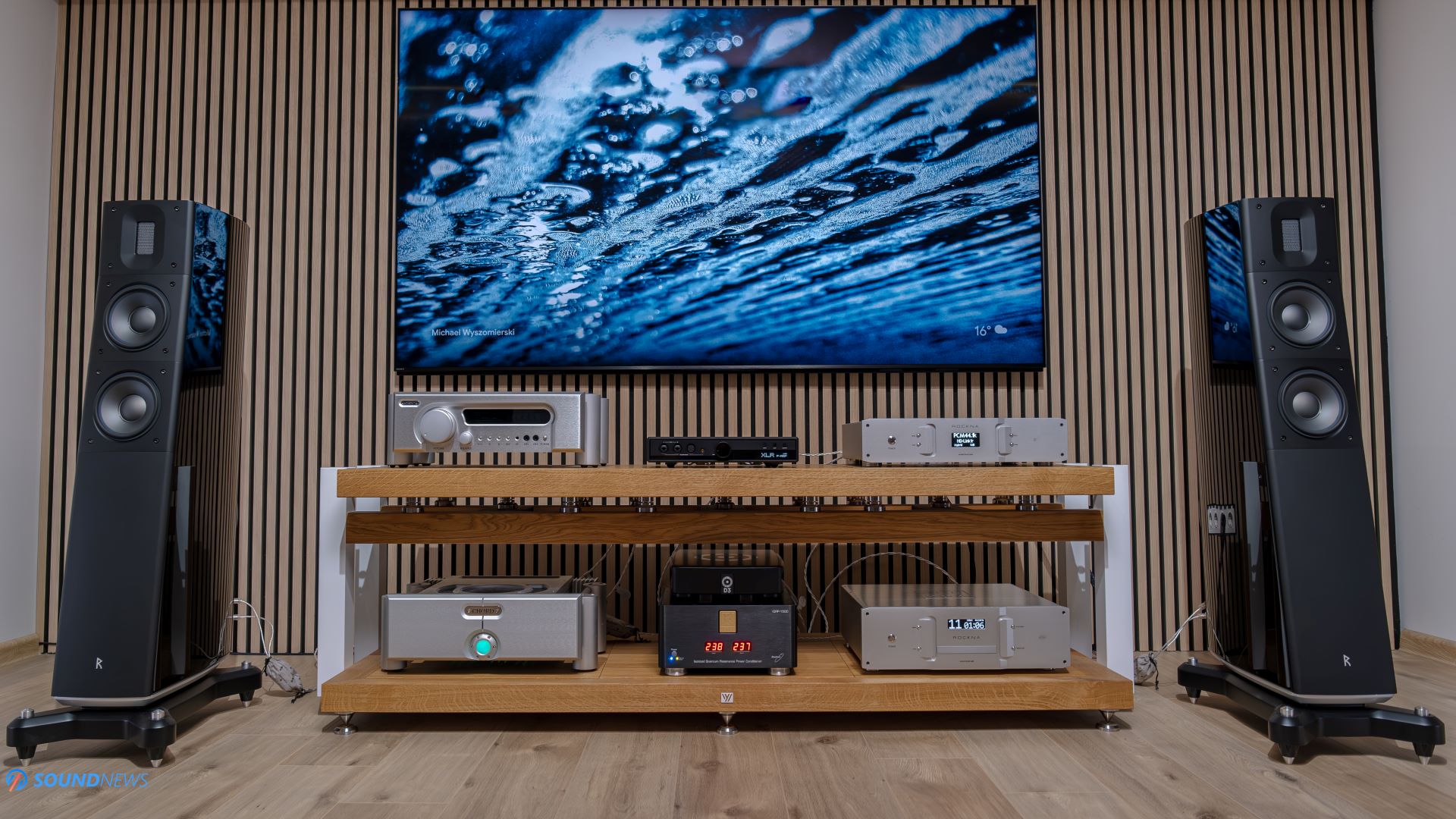
VII. HiFiMan GoldenWave PRELUDE working as a Preamp in Stereo Setup
There are plenty of headphone amplifiers out there that have RCA and XLR outputs you could connect directly to a power amplifier. However, only very few units boast true active line-amplifier circuits. I remember putting the Trafomatic Head 2 between a Chord DAVE and a Chord Ultima 5 power amplifier, which changed my preconceptions about preamplifiers. So much so, that I’m currently rocking a Chord Ultima 2 PRE – the most expensive component from my stereo rig. Then Ferrum OOR followed, which also sounded impressive as a preamplifier. The Burson Voyager did the same thing, but in a different way tonally, and truth be told, I was really curious how the PRELUDE would fare as a standalone preamp.
My loudspeakers are far from sensitive, but at the same time, they are very susceptible to noise coming from downstream equipment. Replacing the Chord Ultima 2 PRE ($19,500) with the PRELUDE didn’t increase the noise floor a single bit, nor did it negatively affect the cleanness and transparency of the sound, which is already a good start. The final result was almost as detailed and clean while adding even more warmth and presence into the midrange region. The scale of the music wasn’t as grand and three-dimensional, and the music didn’t breathe as easily, but that’s understandable given the price difference.
When Dragon In Harmony by Marcin (Qobuz / Tidal) started playing, my kid began jamming left and right, making funny faces and air guitaring like a true professional. I couldn’t leave him standing alone, so I joined in with an invisible drum kit. And I must say, while the PRELUDE didn’t kick the Ultima 2 PRE into the nuts, especially when it came to driver control and soundstage, we still felt great. The tonal balance was spot on, and the guitars vibrated with so much energy, exactly as they should. My former preamplifiers didn’t add as much energy in the midrange, and neither of them was as thick and bold sounding as the PRELUDE. I wish its dynamics were a bit crazier, but hey, we can’t have it all at $2500; some sacrifices still need to be made.
I already have a substantial dose of low-end rumble, and I am happy to know that the PRELUDE didn’t add more of its own. The bass impact remained intact, quantity and quality-wise.
All in all, the PRELUDE can easily replace a dedicated preamplifier. My all-time favorite Headamp/PRE remains the Trafomatic Head 2, but the PRELUDE is not that far away. If you use powered speakers and need a simple volume control, then the PRELUDE works exceptionally well, just make sure to put it into low gain, getting a bit closer to the unity gain.
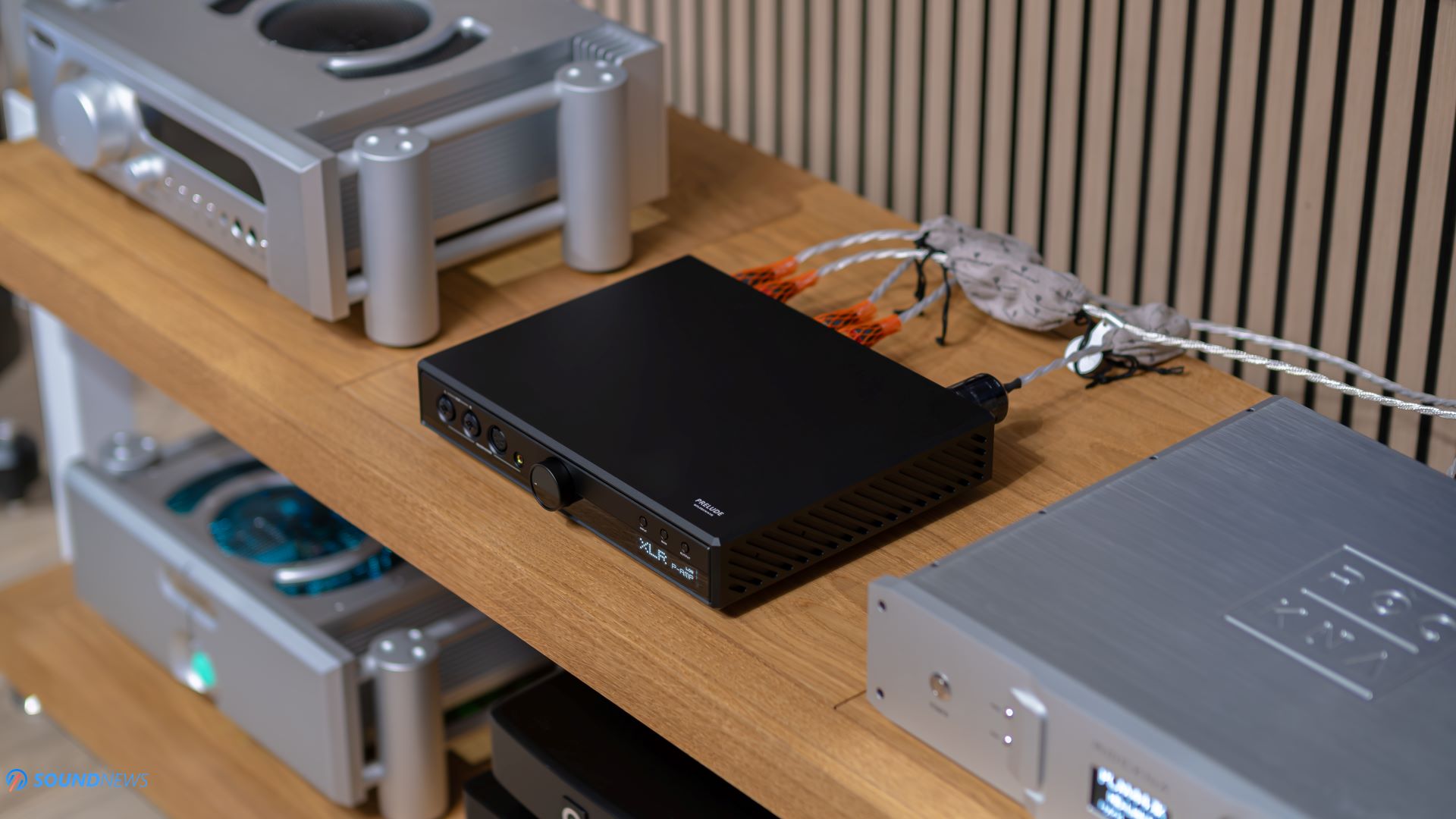
Frequency Response
VIII. Bass
The mighty Susvara shows its fangs in the lowest octaves only when a potent amplifier drives them. You can only guess why most of my purchases were headphone amplifiers starting in 2021… Yeah, Susvara, I’m looking at you. I wasn’t satisfied with their dynamics, and the low-end wasn’t exactly where I wanted it to be. As time passed and additional low-sensitivity headphones were released, headphone amp makers began building bigger, beefier, and scarier amplifiers. A 35-kilo tube headphone amp is already a norm, and Cayin killed it with their newest 42-kilo monstrosity, but more about that in a month or two. The PRELUDE doesn’t fight in the heavyweight category, but it definitely packs a punch thanks to its beefy amplifier stage. The bass is there in the right doses; the sub-bass is clean and articulated, and you can hear additional layers of it with upper-class headphones. The PRELUDE is a basshead-approved material, and its quality is also top-notch. Sometimes I crave a stronger kick down low and maybe a faster overall presentation, but hey! There’s a reason we have pricier amplifiers like the AMP-23R and the freshly released Soul 170HA that pound and slam like angry gorillas not only your eardrums but also your wallet.
Besides the Susvara, I was also surprised by the bass output oozing from the Sennheiser HD800S and T+A Solitaire P. The Solitaire P is known to be a bass lover’s dream, but the HD800S? Barely passable when it comes to bass kick and sustain. The PRELUDE took the HD800S, removed the nasty glare, and bumped the midrange by two notches and the bass by one. The final result? An HD800S done right, with the exact amount of bass, midrange, and treble, sounding much more natural than what I’m usually getting with solid-state amplifiers.
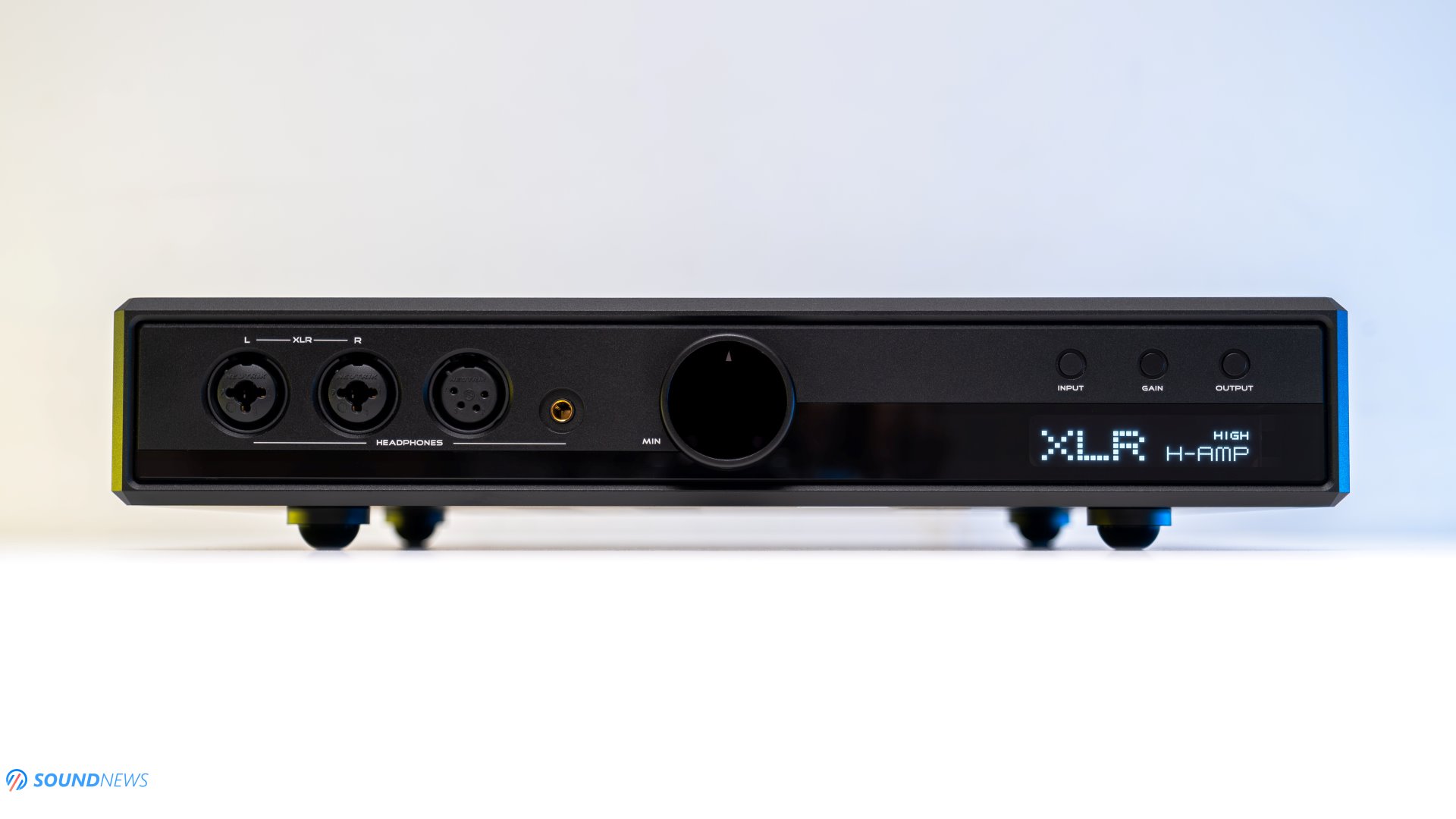
IX. Midrange
The PRELUDE wasn’t tuned as a technical wonder but as a highly enjoyable amplifier that can do justice to every headphone, speaker, and musical genre out there. Considering that 90% of the sounds we hear are located in the midrange region, it’s quintessential to render it as real as possible.
GoldenWave/HiFiMan engineers put a lot of effort into making it sound as natural as possible, and at the end of the day, you are buying the PRELUDE not only for the clean power but for its incredible midrange presence as well. Without a doubt in my mind, the PRELUDE is one of the nicest solid-state amplifiers I have experienced in terms of midrange purity, comparable to what I’ve heard on the Enleum AMP-23R and Holo Audio Bliss KTE. This is where its close competitors can’t match the same level of naturalness. The music feels right when the PRELUDE does the heavy lifting. We must remember why we started this hobby in the first place: it wasn’t for the added resolution, cleanness, or spaciousness but rather because we wanted to enjoy our music a lot more. We wanted to enhance our listening experience, hearing more of everything, while still pumping dopamine into our veins and raising those horns high. The PRELUDE is that kind of amplifier, and maybe you will call it colored sounding in this regard, warm or sweet sounding and I totally get why people are calling it that, but this is the part where I fell in love with its tonality.
If you love complex renditions with tons of acoustic instruments flying all around, and consider yourself a music lover first (or melomaniac, as my buddy Silviu calls himself), you love going with the flow, and enjoy when imagination plays when your favorite tunes kick in, then you need to try the PRELUDE, as simple as that.
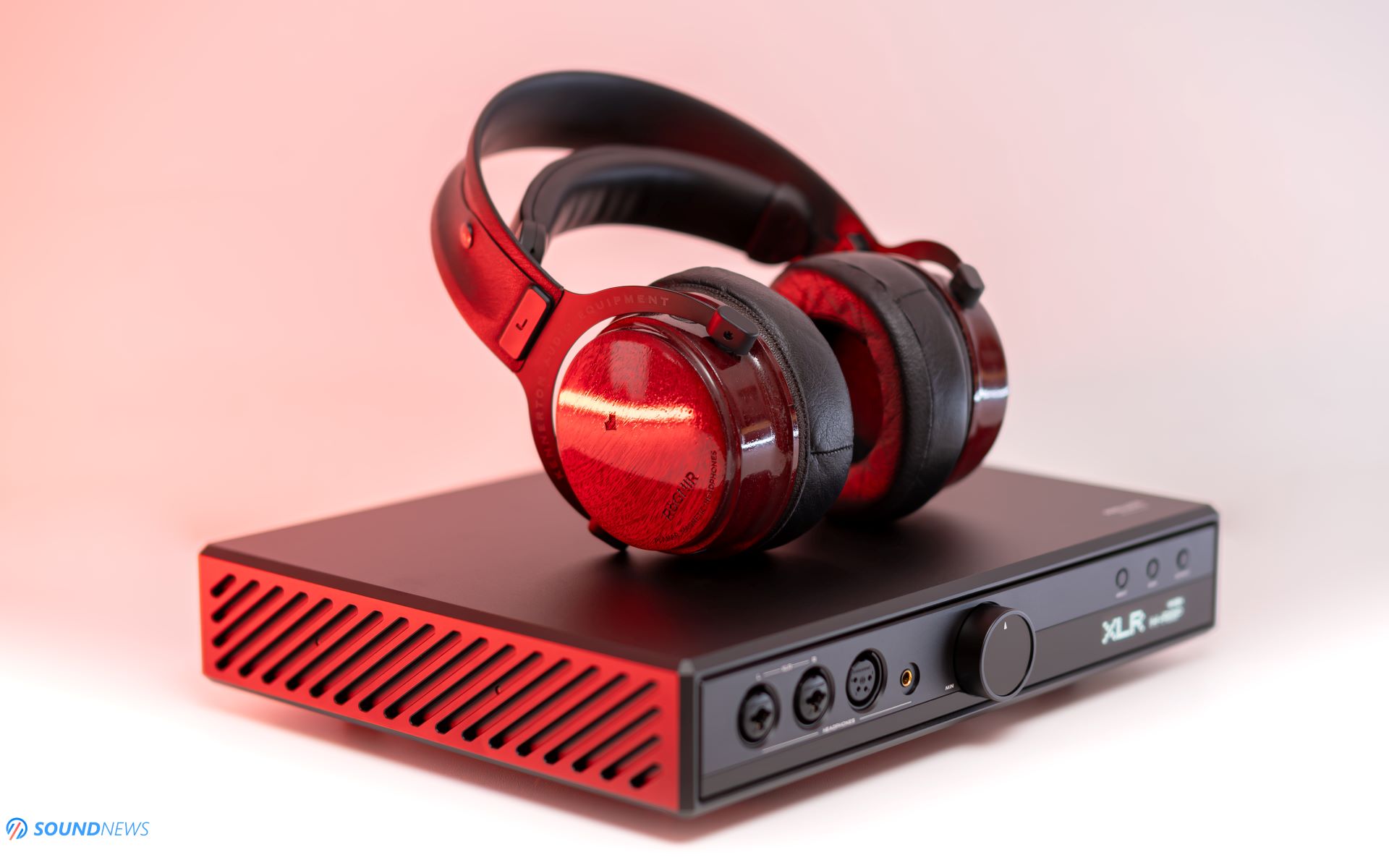
X. Treble
A peculiar thing happens when you fire up some of the nastiest and hottest tracks in your collection. You wonder where the brightness ran off to because it’s no longer residing in your tracks. Trebleheads might be offended by these stunts, but since I’m into all things, including rock and metal, I tend to enjoy my music without changing amplifiers too often. The PRELUDE is a genre master, it plays well with mediocre or plain bad masters and does justice to lit-up metal tunes that went a little overboard on the drum kit. Sure, it’s not the sharpest rendition, nor the most outlined treble I have experienced so far, but let me tell you that after a while, you no longer have the time to deal with sharp-sounding amplifiers that you’ll want to turn off the second the drum player goes wild.
The PRELUDE plays the safe game, and as I’ve mentioned before, it’s almost like several double-triodes were hidden somewhere in there. The trebles are clean and defined, you can hear them shimmer, with natural vibration and decay, but without the nasty ringing associated with entry-level amplifiers. The trebles are softer than usual, and that might work to your advantage if you’re rocking HiFiMan headphones or any of the flagship offerings. The PRELUDE can cure most of the chip-based delta-sigma DACs as well, smoothing out the rough edges, polishing the treble region, and delivering a much more enjoyable sound at the end of the day.
This softer approach to the treble contributes to a more relaxed and natural listening experience, allowing you to focus on the music rather than on the harshness that might distract you from it. For those who prefer long listening sessions without fatigue, the PRELUDE provides an inviting and engaging sound, ensuring that you can enjoy your favorite tracks without worrying about overly bright or sibilant highs. It manages to strike a fine balance, retaining enough treble detail to appreciate the nuances while being forgiving enough for varied master quality, making it a versatile companion for diverse musical tastes.
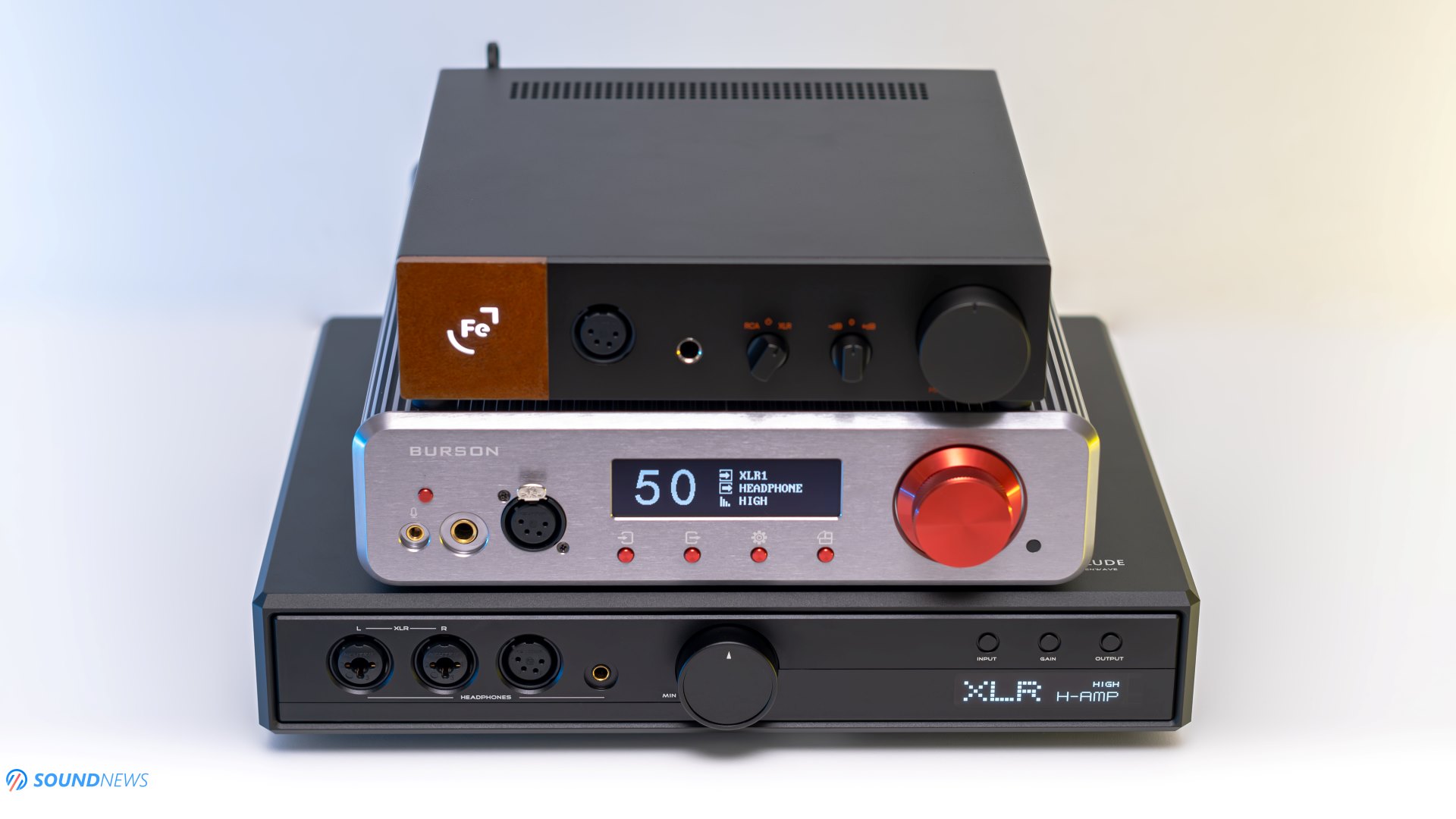
XI. Detailed Comparisons
HiFiMan GoldenWave PRELUDE ($2499) VS Ferrum OOR + HYPSOS ($3190) VS Burson Soloist 3X GT 2023 Deluxe ($2.799)
If you’re a manufacturer and my words are going to offend you, then please accept my apologies, but understand that I need to stay true and honest to my readers and viewers. My opinions are always my own and that isn’t going to change anytime soon. I’ll be as objective as possible, without taking into account my personal preference. If you’re an avid reader, please enjoy the showdown.
All my comparisons are done in the morning, after a hot shower, two poofs of Audispray, a hot coffee, and after volume matching them at 90dB with a decibel meter. All these things are mandatory, as I know that my hearing and mood will be at their prime.
1. Build Quality & Design
PRELUDE’s beautiful casework, ease of use, and simplicity can’t be denied. It has the thickest body, it’s heavier and bigger than the rest and therefore feels more solid, scoring more points than the rest. Ferrum’s designs are also quite special, I particularly like glancing at HYPSOS’s display when dynamics are going wild, the wattage dances in harmony with the load like looking at a digital VU-meter. The OOR and HYPSOS are still unique in my eyes and I find them cleverly designed, they are simple to service and I dig their beautiful PCB layout. Soloist GT comes as impressive and neatly arranged, but it doesn’t stand out as much as the rest, and some might be put off by the spinning Noctua fan that can be heard in complete silence.
- HiFiMan PRELUDE: 10
- Ferrum OOR & Hypsos: 9.5
- Burson Soloist 3X GT: 9
2. Features
When it comes to features, the Soloist 3X GT is winning this round without the right to appeal as besides a three-way Crossfeed circuit for a speaker-like experience, there’s a fully-fledged preamplifier, two sets of XLR and RCA inputs (so helpful when doing source comparisons), a subwoofer output and you can even use your headphones with a subwoofer if you will for some bass heavy action. The Ferrum stack comes feature-packed to its teeth, the HYPSOS in particular is the smartest power supply I’ve encountered to this day, it lets you connect it to almost any DC-powered components and the OOR can also work as a standalone preamplifier. The PRELUDE has no bells or whistles, it’s a pure, analog preamp and headamp, nothing more and nothing less. It rocks two pairs of analog inputs and a mirrored symmetry of analog outputs that will unlock its preamplifier section.
- HiFiMan PRELUDE: 9
- Ferrum OOR & Hypsos: 9.5
- Burson Soloist 3X GT: 10
3. Power Output
When it comes to sheer power numbers, since I’m trying to compare apples to apples here, I’ve recalculated their power ratings in 60 Ohms and it seems that the Ferrum stack takes the lead with its beefier output of ~8 Watts in 60 Ohms, PRELUDE spits about 6.2 juicy Watts in the same load and the Soloist 3X GT outputs a very similar number with its ~6 Watt per channel amp stage. However, when the HiFiMan Susvara started pumping dopamine, I didn’t feel that either of these was lacking oomph or dynamics. They might have different tonalities and skill sets, but all of them were easily driving the heaviest loads with tons of headroom remaining on tap. Nonetheless, I will be ranking them according to their power ratings.
- HiFiMan PRELUDE: 9
- Ferrum OOR & HYPSOS: 10
- Burson Soloist 3X GT: 9
4. Tone & Timbre
When it comes to natural timbres, the PRELUDE is one of the most impressive solid-state amplifiers to date. It sounds more like a top-tier hybrid amplifier, there’s lushness, liquidity, and tactility, plus you can’t beat the overwhelming sensation of “this is how my music should sound!”. Its midrange delivery was second to none, hence scoring the highest points. Ferrum’s stack does very well too and if I would never try the PRELUDE, I would be a happy camper with the OOR and HYPSOS. I still find the OOR mighty impressive, it’s that the PRELUDE is slightly better in this regard. Soloist 3X GT sounds more like a traditional Class-A amplifier, going with a reference tuning, and choosing not to interfere as much with the frequency response. Compared to the rest, the 3X GT adds a brighter sparkle up top, and for trebleheads, it would be a bit more impressive. My reference headphones already have world-class transparency and detail and a slight treble boost might harm their tonal balance.
- HiFiMan PRELUDE: 10
- Ferrum OOR & Hypsos: 9
- Burson Soloist 3X GT: 8.5
5. Soundstage, Layering and Imaging
Moving on to soundstage, layering, and depth information, PRELUDE’s MOSFET-based amplifier section proved more holographic sounding, resembling (again) the sound of a well-made hybrid amplifier. There were more spatial cues and wider spaces between every note and its layering was to die for in both a headphone and stereo setup. Soloist 3X GT was by a hair smaller sounding, narrowing the overall picture, but it still pushed everything outside my head, never messing with open-back headphones. Ferrum OOR came third, as it couldn’t portray a massive scale with orchestral work and it couldn’t provide the same depth information that was coming from the rest. OOR was still great! Outstanding even, just not on the same level.
- HiFiMan PRELUDE: 10
- Ferrum OOR & Hypsos: 8
- Burson Soloist 3X GT: 9
6. Dynamics & Transient Response
Moving on to transients and dynamics, contrary to its power rating, the PRELUDE is a bit slower and softer compared to the rest. It still brings the thunder when nasty electronica suddenly appears on my playlist, but it wasn’t as aggressive or nimble as the 3X GT always pushes its limits, nor as thumpy as the OOR is when driven by the HYPSOS. All of them added lots of oomph and texture, but the last two were snappier and punchier sounding. The Ferrum OOR was still pushing and pulling diaphragms like a bloodthirsty berserker, and the Burson’s creation was by a hair less impactful than its Polish counterpart.
- HiFiMan PRELUDE: 9
- Ferrum OOR & Hypsos: 10
- Burson Soloist 3X GT: 9.5
7. Transparency and Detail Retrieval
I left the hardest test for last, as when it comes to transparency and detail retrieval, all of them are highly resolving. However, if I’m closing my eyes and engage reference high dynamic range tracks, then Soloist 3X GT becomes clearer sounding, removing the muddiness that sometimes might appear on the Ferrum stack, while gently oversharpening the picture. The Soloist is the Alpha from this pack, delivering a clearer overall presentation, albeit at the cost of a less natural presentation. Ferrum’s stack had strong leading edges and thanks to its faster pace, it was a bit sharper sounding as well. However, the PRELUDE let me hear my music with a different mindset. It didn’t impress at first, lacking sharp contours and strong leading edges, but who I’m kidding here, it was a lot more pleasing in its presentation, with its triode-like tonality. The last two amplifiers still have different traits, but their overall resolution is similar.
- HiFiMan PRELUDE: 9
- Ferrum OOR & Hypsos: 9
- Burson Soloist 3X GT: 10
8. Final Results
- HiFiMan PRELUDE: 66 points
- Ferrum OOR & Hypsos: 65 points
- Burson Soloist 3X GT: 65 points
It should be clear by now that all of these amps play in the Big Boy category and I won’t sell one to get the other, only if you like a different flavor. One of these amps should win you over, but I’ll say that the OOR and Soloist 3X GT offer a more traditional fully discrete Class-A sound, while the PRELUDE boosts the colors, beatifies the music, adds a greater sense of spatiality, and infuses more energy into the midrange section.
The PRELUDE is more affordable than the rest, yet it kept its chip up and found its way to the top of this list. It’s one of the most impressive solid-state headphone amplifiers to date and for a good measure, as except for a higher noise floor with sensitive loads, I couldn’t complain much about anything else. Maybe it’s not the most technical-sounding unit and it probably won’t go in and out in a flash like the Soloist 3X GT does so swiftly, but there’s magic in there when music does its mojo.
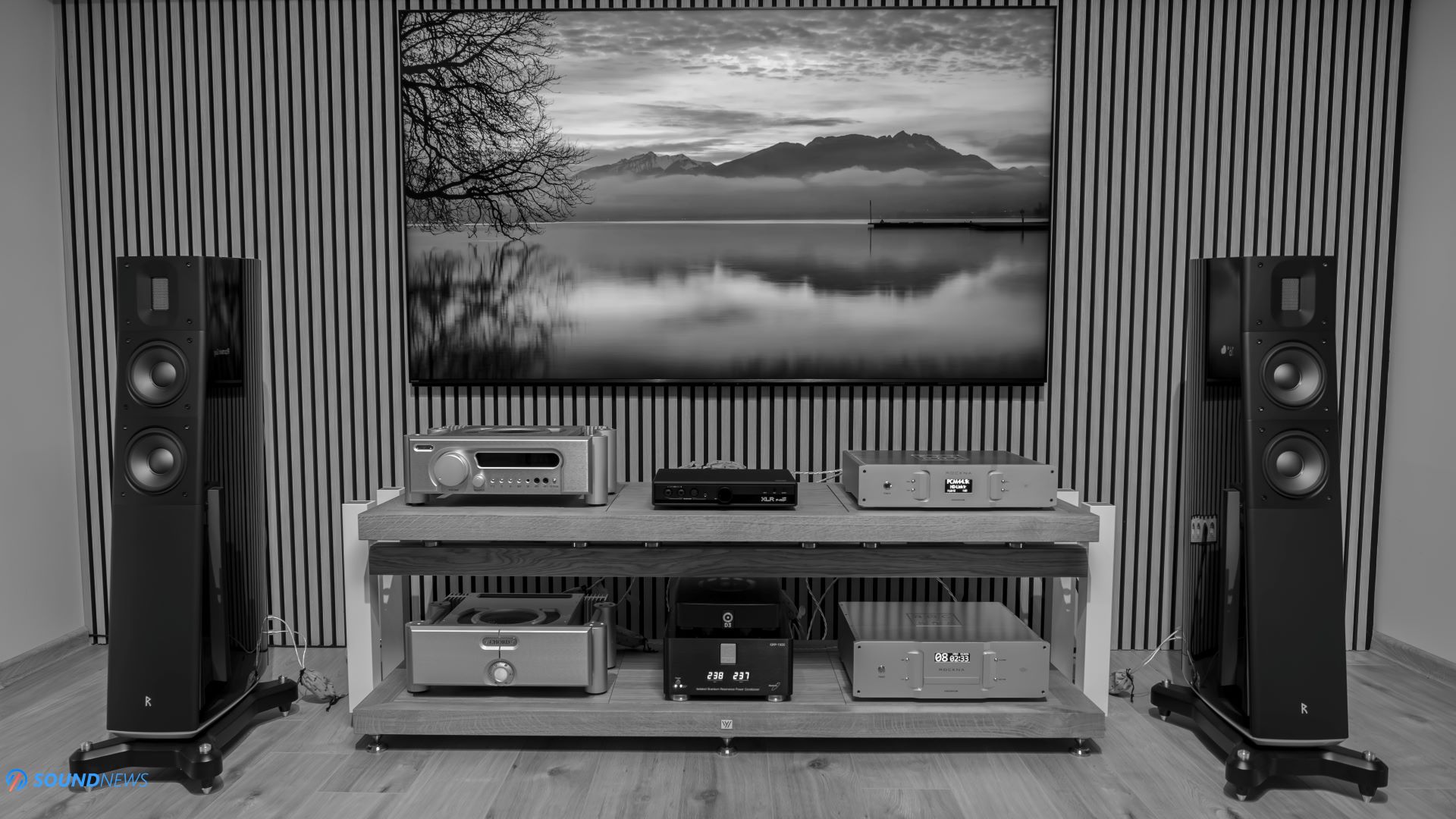
Wrapping Up
Let’s be honest, I didn’t particularly enjoy several design choices. Take the short rubber feet and the plasticky volume knob as good examples. Those are minor things that could be overlooked, but hey! The smallest details can sometimes make the biggest difference. Considering its high current bias and Class A operation, it gets quite hot, and nobody wants to boil their electronics from within, leading to a shorter-than-usual lifespan. Last but not least, if you’re an IEM collector, you might want to look elsewhere or stick with portable DAPs, as the PRELUDE doesn’t offer a satisfactory experience with ultra-sensitive loads. The noise floor is higher than usual, and the volume range is too short to be comfortable.
If you’re already plotting an early Christmas gift for yourself, may I suggest investing in studio-grade footers like the super affordable ISO-Puck Mini by ISO Acoustics? These will elevate the unit from the ground, lowering its working temperature by ~2 degrees Celsius on average. You’ll feel better about your investment, and the unit will have a longer lifespan. It’s a win-win situation with minimal investment.
But let’s look on the bright side, you’re not buying a massive 10-watt per channel beast for sensitive IEMs, are you? This back-in-black unit fought bravely against close competitors and even stood out victorious on several accounts. It ranks among some of the nicest solid-state amplifiers I’ve experienced thus far, which makes it a solid proposition for serious headphone enthusiasts who don’t want to break the bank entirely.
True, it’s not Enleum AMP-23R material nor a Soloist Voyager killer (especially when powered by a Fusion Core), but hey, it’s several times cheaper, yet exactly as enjoyable, powerful, and effortless.
Many of you are probably wondering if this is the right choice for your ever-growing HiFiMan collection. And that’s the wrong question, lads! It paired well with my Sennheiser, Meze, T+A, Kennerton Audio, and Erzetich Audio headphones due to its universal tuning and high-power delivery. It connected with my tunes in ways that only hybrid or full-tube amplifiers were capable of, without revealing their obvious drawbacks. And let’s not forget its meaty tone and warm cuddles when it replaced my Chord Ultima 2 PRE, sounding like a proper preamp while bumping the fun factor to cloud nine.

The HiFiMan GoldenWave PRELUDE fully deserves our Silver Award, and I’m looking forward to their future developments. It can be yours for $2499 in the USA and €2699 in Europe from your local HiFiMan dealer. You can also get one directly from HiFiMan right here.
If you take the plunge and have some burning questions, feel free to drop me a line in the comments section below. That’s all for now, Sandu’s signing out!
PROS:
- Tank-proof case & rock solid built quality
- Elegant-looking with a clever heat dissipation design
- A 2-in-1 unit that offers both single-ended and balanced connections, in and out.
- Carries a life-like tonality and right tone that sets it apart from the others
- The soundstage is quite holographic and deep for a solid-state amplifier as if double triodes were hidden somewhere in there
- While the background noise is still there with ultra-sensitive IEMs, it’s no longer audible with sensitive desktop headphones (Hello Apos Caspian and all the Focal and Grado headphones)
- Pushes resolution and detail retrieval high, without slashing your eardrums with sharp katanas
- Covers the frequency response in full, while planting a bit more life in the midrange and bass regions
- Easily drove my entire headphone collection, leaving a ton of headroom on tap
- Great low-end delivery and extension, albeit not in the fastest way
- Excellent pre-amplifier section
- Offers good control over headphone and speaker drivers
- The final sound was refined and effortless on all accounts as if the amp never stressed to do its main job
- Engaging sounding at all times
- Well worth its asking price
CONS:
- Short rubber feet on such a gorgeous-looking all-metal amplifier aren’t that cool-cooling
- A plasticky volume knob, low physical resistance
- Short volume travel with sensitive loads
- There is little to no difference between the Low and High gain positions. It should be at least 10 dB, but we have only a modest ~2 dB increase
- The noise is audible with ultra-sensitive IEMs
- Gets hot after about an hour of use
- Not the fastest transient response
ASSOCIATED EQUIPMENT:
- Digital Transport / Roon Server/ Streamer: Rockna Wavedream NET 4 Tb
- Network Switch: Ansuz PowerSwitch D3
- DACs: Rockna Wavedream Signature XLR, LAiV Harmony
- Headphone Amplifiers: HiFiMan PRELUDE, Ferrum OOR & HYPSOS, Burson Soloist 3X GT, Soloist Voyager, Trafomatic Primavera, Enleum AMP-23R
- Preamplifier: Chord Electronics Ultima 2 PRE
- Power Amplifier: Chord Electronics Ultima 5
- Full-sized headphones: HiFiMan Susvara, T+A Solitaire P & many others (15+)
- Loudspeakers: Raidho TD 2.2
- Interconnects: Crystal Cable Art Series Monet XLR (X2)
- Speaker cables: Crystal Cable Art Series Monet
- Power Cables: Crystal Cable Art Series Monet (X4), Neotech NEP-1001 (X2)
- Ethernet Cable: Crystal Cable Art Series Monet
- HDMI Cable: AudioQuest Dragon
- Balanced Isolation Power Conditioners: KECES IQPR-1500 (stereo setup), PLiXiR Elite BAC 1500 (headphone setup)
